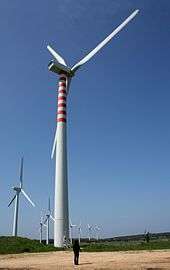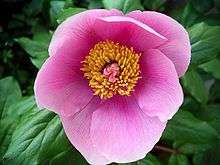Sardinia
| Sardinia Sardegna (Italian) Sardigna (Sardinian) Sardenya (Catalan) | |||
|---|---|---|---|
| Autonomous region of Italy | |||
 | |||
| |||
 | |||
| Country | Italy | ||
| Capital | Cagliari | ||
| Government | |||
| • President | Francesco Pigliaru (PD) | ||
| Area | |||
| • Total | 24,090 km2 (9,300 sq mi) | ||
| Population (June 2014) | |||
| • Total | 1,656,003 | ||
| • Density | 69/km2 (180/sq mi) | ||
| Demonym(s) | Sardinian | ||
| Citizenship[1] | |||
| • Italian | 97% | ||
| Time zone | CET (UTC+1) | ||
| • Summer (DST) | CEST (UTC+2) | ||
| GDP/ Nominal | €33.6[2] billion (2011) | ||
| GDP per capita | €20,071[2] (2011) | ||
| NUTS Region | ITG | ||
| Website | www.regione.sardegna.it | ||
Sardinia (/sɑːrˈdɪniə/ sar-DIN-ee-ə; Italian: Sardegna [sarˈdeɲɲa], Sardinian: Sardìgna/Sardìnnia [sarˈdiɲɲa]/[sarˈdinja], Sassarese: Sardhigna, Gallurese: Saldigna, Catalan: Sardenya, Tabarchino: Sardegna) is the second largest island in the Mediterranean Sea (after Sicily and before Cyprus) and an autonomous region of Italy. It is located in the Western Mediterranean, to the immediate south of the French island of Corsica.
The region's official name is Regione Autonoma della Sardegna / Regione Autònoma de Sardigna (Autonomous Region of Sardinia),[3] and its capital and largest city is Cagliari. It is divided into four provinces and a metropolitan city. Its indigenous language and the other minority languages (Sassarese, Corsican Gallurese, Algherese Catalan and Ligurian Tabarchino) spoken by the Sardinians enjoy "equal dignity" with Italian under regional law.[4]
Etymology
The name Sardinia is from the pre-Roman noun *s(a)rd-, later romanised as sardus (feminine sarda). It makes its first appearance on the Nora Stone, where the word Šrdn testifies to the name's existence when the Phoenician merchants first arrived.[5] According to Timaeus, one of Plato's dialogues, Sardinia and its people as well might have been named after Sardò (Σαρδώ), a legendary woman born in Sardis (Σάρδεις), capital of the ancient Kingdom of Lydia.[6][7] There has also been speculation that identifies the ancient Nuragic Sards with the Sherden, one of the Sea Peoples.[8][9] It is suggested that the name had a religious connotation from its use also as the adjective for the ancient Sardinian mythological hero-god Sardus Pater[10] "Sardinian Father" (in modern times misunderstood as being "Father Sardus"), as well as being the stem of the adjective "sardonic". In Classical antiquity, Sardinia was called Ichnusa (the Latinised form of Ancient Greek: Υκνούσσα), Σανδάλιον "Sandal", Sardinia and Sardó (Σαρδώ).
Geography
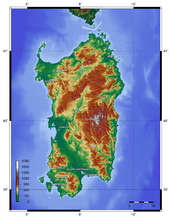
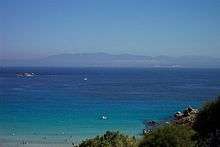
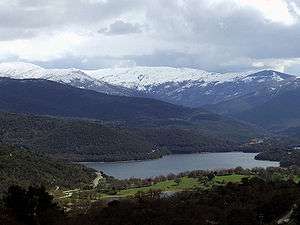
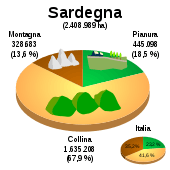
Sardinia is the second-largest island in the Mediterranean Sea (after Sicily and before Cyprus), with an area of 24,100 square kilometres (9,305 sq mi). It is situated between 38° 51' and 41° 18' latitude north (respectively Isola del Toro and Isola La Presa) and 8° 8' and 9° 50' east longitude (respectively Capo dell'Argentiera and Capo Comino). To the west of Sardinia is the Sea of Sardinia, a unit of the Mediterranean Sea; to Sardinia's east is the Tyrrhenian Sea, which is also an element of the Mediterranean Sea.[11]
The nearest land masses are (clockwise from north) the island of Corsica, the Italian Peninsula, Sicily, Tunisia, the Balearic Islands, and Provence. The Tyrrhenian Sea portion of the Mediterranean Sea is directly to the east of Sardinia between the Sardinian east coast and the west coast of the Italian mainland peninsula. The Strait of Bonifacio is directly north of Sardinia and separates Sardinia from the French island of Corsica.
The coasts of Sardinia (1,849 kilometres (1,149 miles) long) are generally high and rocky, with long, relatively straight stretches of coastline, many outstanding headlands, a few wide, deep bays, rias, many inlets and with various smaller islands off the coast.
The island has an ancient geoformation and, unlike Sicily and mainland Italy, is not earthquake-prone. Its rocks date in fact from the Palaeozoic Era (up to 500 million years old). Due to long erosion processes, the island's highlands, formed of granite, schist, trachyte, basalt (called jaras or gollei), sandstone and dolomite limestone (called tonneri or "heels"), average at between 300 to 1,000 metres (984 to 3,281 feet). The highest peak is Punta La Marmora (Perdas Carpìas in Sardinian language)(1,834 m (6,017 ft)), part of the Gennargentu Ranges in the centre of the island. Other mountain chains are Monte Limbara (1,362 m (4,469 ft)) in the northeast, the Chain of Marghine and Goceano (1,259 m (4,131 ft)) running crosswise for 40 kilometres (25 miles) towards the north, the Monte Albo (1,057 m (3,468 ft)), the Sette Fratelli Range in the southeast, and the Sulcis Mountains and the Monte Linas (1,236 m (4,055 ft)). The island's ranges and plateaux are separated by wide alluvial valleys and flatlands, the main ones being the Campidano in the southwest between Oristano and Cagliari and the Nurra in the northwest.
Sardinia has few major rivers, the largest being the Tirso, 151 km (94 mi) long, which flows into the Sea of Sardinia, the Coghinas (115 km) and the Flumendosa (127 km). There are 54 artificial lakes and dams that supply water and electricity. The main ones are Lake Omodeo and Lake Coghinas. The only natural freshwater lake is Lago di Baratz. A number of large, shallow, salt-water lagoons and pools are located along the 1,850 km (1,150 mi) of the coastline.
Climate
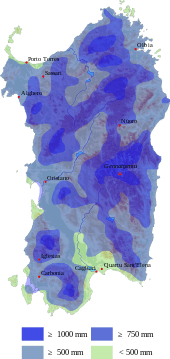
The climate of the island is variable from area to area, due to several factors including the extension in latitude and the elevation. It can be classified in two different macrobioclimates (Mediterranean pluviseasonal oceanic and Temperate oceanic), one macrobioclimatic variant, called Submediterranean, and four classes of continentality (from weak semihyperoceanic to weak semicontinental), eight thermotypic horizons (from lower thermomediterranean to upper supratemperate) and seven ombrotypic horizons (from lower dry to lower hyperhumid), resulting in a combination of 43 different isobioclimates.[12]
During the year there is a major concentration of rainfall in the winter and autumn, some heavy showers in the spring and snowfalls in the highlands. The average temperature is between 11 to 17 °C (52 to 63 °F), with mild winters and hot summers on the coasts ( 9 to 11 °C (48 to 52 °F) in January, 23 to 26 °C (73 to 79 °F) in July), and cold winters and cool summers on the mountains ( −2 to 4 °C (28 to 39 °F) in January, 16 to 20 °C (61 to 68 °F) in July).
Rainfall has a Mediterranean distribution all over the island, with almost totally rainless summers and wet autumns, winters and springs. However, in summer, the rare rainfalls can be characterized by short but severe thunderstorms, which can cause flash floods. The climate is also heavily influenced by the vicinity of the Gulf of Genoa (barometric low) and the relative proximity of the Atlantic Ocean. Low pressures in autumn can generate the formation of the so-called Medicanes, extratropical cyclones which affect the Mediterranean basin. In 2013, the island was hit by several cyclones, included the Cyclone Cleopatra, which dumped almost 18 inches (450 mm) of rainfall within an hour and a half.[13] Sardinia being relatively large and hilly, weather is not uniform; in particular the East is drier, but paradoxically it suffers the worst rainstorms : in autumn 2009, it rained more than 200 mm (7.9 in) in a single day in Siniscola, and 19 November 2013, locations in Sardinia were reported to have received more than 431 mm (17 inches) within two hours. The western coast has a higher distribution of rainfalls even for modest elevations (for instance Iglesias, elevation 200 m (656 ft), average annual precipitation 815 mm (32.1 in)). The driest part of the island is the coast of Cagliari gulf, with less than 450 mm (17.7 in) per year, the minimum is at Capo Carbonara at the extreme south-east of the island 381 mm (15.0 in),[14] and the wettest is the top of the Gennargentu mountain with almost 1,500 mm (59.1 in) per year. The average for the entire island is about 800 mm (31.5 in) per year, which is more than enough for the needs of the population and vegetation.[15] The Mistral from the northwest is the dominant wind on and off throughout the year, though it is most prevalent in winter and spring. It can blow quite strongly, but it is usually dry and cool.
| Climate data for Cagliari, altitude 4 m | |||||||||||||
|---|---|---|---|---|---|---|---|---|---|---|---|---|---|
| Month | Jan | Feb | Mar | Apr | May | Jun | Jul | Aug | Sep | Oct | Nov | Dec | Year |
| Average high °C (°F) | 14.3 (57.7) |
14.8 (58.6) |
16.5 (61.7) |
18.6 (65.5) |
22.9 (73.2) |
27.3 (81.1) |
30.4 (86.7) |
30.8 (87.4) |
27.4 (81.3) |
23.1 (73.6) |
18.3 (64.9) |
15.4 (59.7) |
21.7 (71.1) |
| Daily mean °C (°F) | 9.9 (49.8) |
10.3 (50.5) |
11.8 (53.2) |
13.7 (56.7) |
17.7 (63.9) |
21.7 (71.1) |
24.7 (76.5) |
25.2 (77.4) |
22.3 (72.1) |
18.4 (65.1) |
13.8 (56.8) |
11.0 (51.8) |
16.7 (62.1) |
| Average low °C (°F) | 5.5 (41.9) |
5.8 (42.4) |
7.1 (44.8) |
8.9 (48) |
12.4 (54.3) |
16.2 (61.2) |
18.9 (66) |
19.6 (67.3) |
17.1 (62.8) |
13.7 (56.7) |
9.3 (48.7) |
6.6 (43.9) |
11.8 (53.2) |
| Average rainfall mm (inches) | 49.7 (1.957) |
53.3 (2.098) |
40.4 (1.591) |
39.7 (1.563) |
26.1 (1.028) |
11.9 (0.469) |
4.1 (0.161) |
7.5 (0.295) |
34.9 (1.374) |
52.6 (2.071) |
58.4 (2.299) |
48.9 (1.925) |
427.5 (16.831) |
| Average rainy days (≥ 1.0 mm) | 6.8 | 6.8 | 6.8 | 7.0 | 4.4 | 2.1 | 0.8 | 1.3 | 4.3 | 6.5 | 7.4 | 7.4 | 61.6 |
| Mean monthly sunshine hours | 136.4 | 139.2 | 186.0 | 213.0 | 269.7 | 288.0 | 334.8 | 310.0 | 246.0 | 198.4 | 147.0 | 127.1 | 2,595.6 |
| Source: Servizio Meteorologico,[16] Hong Kong Observatory[17] for data of sunshine hours | |||||||||||||
| Climate data for Fonni, altitude 1029 m | |||||||||||||
|---|---|---|---|---|---|---|---|---|---|---|---|---|---|
| Month | Jan | Feb | Mar | Apr | May | Jun | Jul | Aug | Sep | Oct | Nov | Dec | Year |
| Average high °C (°F) | 6.6 (43.9) |
6.9 (44.4) |
8.9 (48) |
11.5 (52.7) |
16.3 (61.3) |
21.2 (70.2) |
25.8 (78.4) |
25.5 (77.9) |
21.7 (71.1) |
16.4 (61.5) |
10.9 (51.6) |
8.1 (46.6) |
15.0 (59) |
| Daily mean °C (°F) | 4.1 (39.4) |
4.1 (39.4) |
5.7 (42.3) |
8.1 (46.6) |
12.4 (54.3) |
16.9 (62.4) |
21.1 (70) |
20.9 (69.6) |
17.7 (63.9) |
13.1 (55.6) |
8.2 (46.8) |
5.5 (41.9) |
11.5 (52.7) |
| Average low °C (°F) | 1.5 (34.7) |
1.2 (34.2) |
2.5 (36.5) |
4.6 (40.3) |
8.5 (47.3) |
12.6 (54.7) |
16.4 (61.5) |
16.3 (61.3) |
13.7 (56.7) |
9.7 (49.5) |
5.4 (41.7) |
2.8 (37) |
7.9 (46.2) |
| Average rainfall mm (inches) | 97 (3.82) |
118 (4.65) |
110 (4.33) |
88 (3.46) |
73 (2.87) |
33 (1.3) |
11 (0.43) |
18 (0.71) |
40 (1.57) |
93 (3.66) |
107 (4.21) |
131 (5.16) |
919 (36.18) |
| Average rainy days (≥ 1.0 mm) | 9.9 | 10.0 | 9.4 | 10.5 | 7.4 | 4.2 | 1,6 | 2.4 | 4.8 | 8.8 | 9.7 | 9.9 | 88.6 |
| Source: Servizio Meteorologico | |||||||||||||
History

Prehistory
Sardinia is one of the most geologically ancient bodies of land in Europe. The island was populated in various waves of immigration from prehistory until recent times.
The first people to settle in Sardinia during the Upper Paleolithic and the Mesolithic came probably from the Iberian Peninsula and the Italian Peninsula; the Paleolithic colonization of the island is demonstrated by the evidences in Oliena's Corbeddu Cave[18] in the Mesolithic some populations, particularly from present-day Tuscany, managed to move to northern Sardinia via Corsica.[18] The Neolithic Revolution was introduced in the 6th millennium BC by the Cardial culture coming from the Italian Peninsula. In the mid-Neolithic period, the Ozieri culture, probably of Aegean origin, flourished on the island spreading the hypogeum tombs known as domus de Janas, while the Arzachena culture of Gallura built the first megaliths: circular tombs. In the early 3rd millennium BC, the metallurgy of copper and silver began to develop.
During the late Chalcolithic, the so-called Beaker culture, coming from Continental Europe, appeared in Sardinia. These new people predominantly settled on the west coast, where the majority of the sites attributed to them had been found.[19] The Beaker culture was followed in the early Bronze Age by the Bonnanaro culture which showed both reminiscences of the Beaker and influences by the Polada culture.
As time passed, the different Sardinian populations appear to have become united in customs, yet remained politically divided into various small, tribal groupings, at times banding together, and at others waging war against each other. Habitations consisted of round thatched stone huts.
Nuragic civilization
From about 1500 BC onwards, villages were built around round tower-fortresses called nuraghi[20] (singular form "Nuraghe", usually pluralized in English as "Nuraghes"). These towers were often reinforced and enlarged with battlements. Tribal boundaries were guarded by smaller lookout Nuraghes erected on strategic hills commanding a view of other territories.
Today, some 7,000 Nuraghes dot the Sardinian landscape. While initially these Nuraghes had a relatively simple structure, with time they became extremely complex and monumental (see for example Nuraghe Santu Antine, Su Nuraxi, or Nuraghe Arrubiu). The scale, complexity and territorial spread of these buildings attest to the level of wealth accumulated by the Nuragic people, their advances in technology and the complexity of their society, which was able to coordinate large numbers of people with different roles for the purpose of building the monumental Nuraghes.

The Nuraghes are not the only Nuragic buildings that survive, as there are several sacred wells around Sardinia and other buildings that had religious purposes such as the Giants' grave (monumental collective tombs) and collections of religious buildings that probably served as destinations for pilgrimage and mass religious rites (e.g. Su Romanzesu near Bitti).

Sardinia was at the time at the centre of several commercial routes and it was an important provider of raw materials such as copper and lead, which were pivotal for the manufacture of the time. By controlling the extraction of these raw materials and by commercing them with other countries, the Nuragic civilisation was able to accumulate wealth and reach a level of sophistication that is not only reflected in the complexity of its surviving buildings, but also in its artworks (e.g. the votive bronze statuettes found across Sardinia).
According to some scholars, the Nuragic people(s) are identifiable with the Sherden, a tribe of the "Sea Peoples".[21]
The Nuragic civilization was linked with other contemporaneous megalithic civilization of the western Mediterranean, such as the Talaiotic culture of the Balearic Islands and the Torrean civilization of South Corsica. Evidence of trade with the other civilizations of the time is attested by several artefacts (e.g. pots), coming from as far as Cyprus, Crete, Mainland Greece, Spain and Italy, that have been found in Nuragic sites, bearing witness to the scope of commercial relations between the Nuragic people and other peoples in Europe and beyond.
Ancient history
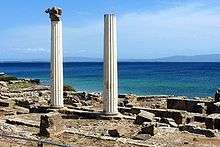

Around the 9th century BC the Phoenicians began visiting Sardinia with increasing frequency, presumably initially needing safe over-night and/or all-weather anchorages along their trade routes from the coast of modern-day Lebanon as far afield as the African and European Atlantic coasts and beyond. The most common ports of call were Caralis, Nora, Bithia, Sulci, and Tharros. Claudian, a 4th-century Latin poet, in his poem De bello Gildonico, stated that Caralis was founded by people from Tyre, probably in the same time of the foundation of Carthage, in the 9th or 8th century BC.[22]
In the 6th century BC, after the conquest of western Sicily, the Carthaginians planned to annex Sardinia.[23] A first invasion attempt led by Malco was foiled by the victorious Nuraghic resistance. However, from 510 BC, the southern and west-central part of the island was invaded a second time and came under Carthaginian rule.[23][24]
In 238 BC, taking advantage of Carthage having to face a rebellion of her mercenaries (the Mercenary War) after the First Punic War (264–241 BC), the Romans annexed Corsica and Sardinia from the Carthaginians. The two islands became the province of Corsica and Sardinia. They were not given a provincial governor until 227 BC. The Romans faced many rebellions, and it took them many years to pacify both islands. The existing coastal cities were enlarged and embellished, and Roman colonies such as Turris Lybissonis and Feronia were founded. These were populated by Roman immigrants. The Roman military occupation brought the Nuragic civilization to an end, except for the mountainous interior of the island, which the Romans called Barbaria, meaning “Barbarian land”. Roman rule in Sardinia lasted 694 years, during which time the province was an important source of grain for the capital. Latin came to be the dominant spoken language during this period, though Roman culture was slower to take hold, and Roman rule was often contested by the Sardinian tribes from the mountainous regions.[25]
Vandal conquest

The east Germanic tribe of the Vandals conquered Sardinia in 456. Their rule lasted for 78 years up to 534, when 400 eastern Roman troops led by Cyril, one of the officers of the foederati, retook the island. It is known that the Vandal government continued the forms of the existing Roman Imperial structure. The governor of Sardinia continued to be called the praeses and apparently continued to manage military, judicial, and civil governmental functions via imperial procedures. The only Vandal governor of Sardinia about whom there is substantial record is the last, Godas, a Visigoth noble. In AD 530, a coup d'état in Carthage removed King Hilderic, a convert to Nicene Christianity, in favor of his cousin Gelimer, an Arian Christian like most of the élite in his kingdom. Godas was sent to take charge and ensure the loyalty of Sardinia. He did the exact opposite, declaring the island's independence from Carthage[26] and opening negotiations with Emperor Justinian I, who had declared war on Hilderic's behalf. In AD 533 Gelimer sent the bulk of his army and navy (120 vessels and 5,000 men) to Sardinia to subdue Godas, with the catastrophic result that the Vandal Kingdom was overwhelmed when Justinian's own army under Belisarius arrived at Carthage in their absence. The Vandal Kingdom ended and Sardinia was returned to Roman rule.[27]
Byzantine era and the rise of the giudicati
In 533, Sardinia returned to the rule of the Byzantine Empire when the Vandals were defeated by the armies of Justinian I under the General Belisarius in the Battle of Tricamarum, in their African kingdom; Belisarius sent his general Cyril to Sardinia to retake the island. Sardinia remained in Byzantine hands for the next 300 years[28] aside from a short period in which it was invaded by the Ostrogoths in 551.
Under Byzantine rule, the island was divided into districts called mereíai (μερείαι) in Byzantine Greek, which were governed by a judge residing in Caralis and garrisoned by an army stationed in Forum Traiani (today Fordongianus) under the command of a dux.[29] During this time, Christianity took deeper root on the island, supplanting the Paganism which had survived into the early Middle Ages in the culturally conservative hinterlands. Along with lay Christianity, the followers of monastic figures such as Basil of Caesarea became established in Sardinia. While Christianity penetrated the majority of the population, the region of Barbagia remained largely pagan and, probably, partially non-Latin speaking. They re-established a short-lived independent domain with Sardinian-heathen lay and religious traditions, one of its kings being Hospito.[30][31] Pope Gregory I wrote a letter to Hospito defining him "Dux Barbaricinorum" and, being Christian, the leader and best of his people.[32] In this unique letter about Hospito, the Pope prompts him to convert his people who “living all like irrational animals, ignore the true God and worship wood and stone” (Barbaricini omnes, ut insensata animalia vivant, Deum verum nesciant, ligna autem et lapides adorent).[33]
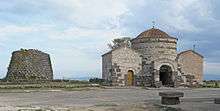
The dates and circumstances of the end of Byzantine rule in Sardinia are not known. Direct central control was maintained at least through c. 650, after which local legates were empowered in the face of the rebellion of Gregory the Patrician, Exarch of Africa and the first invasion of the Muslim conquest of the Maghreb. There is some evidence that senior Byzantine administration in the Exarchate of Africa retreated to Caralis following the final fall of Carthage to the Arabs in 697.[34] The loss of imperial control in Africa led to escalating raids by Moors and Berbers on the island, the first of which is documented in 705, forcing increased military self-reliance in the province.[35] Communication with the central government became daunting if not impossible during and after the Muslim conquest of Sicily between 827 and 902. A letter by Pope Nicholas I as early as 864 mentions the "Sardinian judges",[36] without reference to the empire and a letter by Pope John VIII (reigned 872–882) refers to them as principes ("princes"). By the time of De Administrando Imperio, completed in 952, the Byzantine authorities no longer listed Sardinia as an imperial province, suggesting they considered it lost.[34] In all likelihood a local noble family acceded to the power, still identifying themselves as vassals of the Byzantines, but de facto independent as communications with Constantinople were very difficult. We know only two names of those rulers, Salusios (Σαλούσιος) and the protospatharios Turcoturios (Tουρκοτούριος) from two inscriptions[37][38][39]), who probably reigned between the 10th and the 11th century. These rulers were still closely linked to the Byzantines, both for a pact of ancient vassalage,[40] and from the ideological point of view, with the use of the Greek language (in a country of the romance language), and the use of art of Byzantine inspiration.
In the early 11th century, an attempt to conquer the island was made by Muslims based in Spain.[41] The only records of that war are from Pisan and Genoese chronicles.[42] The Christians won, but after that, the previous Sardinian kingdom was totally undermined and divided into four small giudicati: Cagliari (Calari), Arborea (Arbaree), Gallura, Torres or Logudoro.
Whether this final transformation from imperial civil servant to independent sovereign resulted from imperial abandonment or local assertion, by the 10th century, the giudici (Sardinian: judikes / Latin: iudices, literally "judges", a Byzantine administrative title) had emerged as the autonomous rulers of Sardinia. The title of iudice changed with the language and local understanding of the position, becoming the Sardinian judike, essentially a king or sovereign, while giudicato (Sardinian: judicadu), literally ‘judgeship’ or ‘judicature’, came to mean "state". A letter by Mieszko I of Poland to Pope John XV proves that the Giudicati were known even in Poland, and that they played an important role in Medieval Europe.[43]
Early medieval Sardinian political institutions evolved from the millennium-old Roman imperial structures with relatively little Germanic influence.
Although the Giudicati were hereditary lordships, the old Byzantine imperial notion that personal title or honor was separate from the state still remained, so the Giudicato was not regarded as the personal property of the monarch as was common in later European feudalism. Like the imperial systems, the new order also preserved "semi-democratic" forms, with national assemblies called the Crown of the Realm. Each Giudicato saw to its own defense, maintained its own laws and administration, and looked after its own foreign and trading affairs.[44]
The history of the four Giudicati would be defined by the contest for influence between the rival rising sea powers of Genoa and Pisa, and later the ambitions of the Kingdom of Aragon.
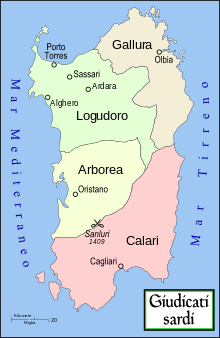
The Giudicato of Cagliari (or Pluminos), during the regency of Torchitorio V of Cagliari and his successor, William III, was allied with the Republic of Genoa. For this it was brought to an end in 1258, when its capital, Santa Igia, was stormed and destroyed by an alliance of Sardinian and Pisan forces. The territory then was divided between Republic of Pisa, the Della Gherardesca family and the Giudicati of Arborea and Gallura. Pisa maintained the control over the fortress of Castel di Cagliari founded by Pisan merchants in 1216/1217 east of Santa Igia;[45] in the south-west the count Ugolino della Gherardesca promoted the birth of the town of Villa di Chiesa (today Iglesias) to exploit the nearby rich silver deposits.[46]
The Giudicato of Logudoro (sometimes called Torres) was also allied to the Republic of Genoa and came to an end in 1259 after the death of the judikessa (queen) Adelasia. The territory was divided up between the Doria and Malaspina families of Genoa and the Bas-Serra family of Arborea, while the city of Sassari became a small republic, like the Italian city-states (comuni), confederated firstly with Pisa and then with Genoa.[47]
The Giudicato of Gallura ended in the year 1288, when the last giudice, Nino Visconti (a friend of Dante Alighieri), was driven out by the Pisans, who occupied the territory.[48]
The Giudicato of Arborea, having Oristano as its capital, had a longer life compared to the other kingdoms. Its later history is entwined with the attempt to unify the island into a single Sardinian state (Republica Sardisca) against their relatives and former Aragonese allies.
Aragonese period
In 1297, Pope Boniface VIII established on his own initiative (motu proprio) a hypothetical regnum Sardiniae et Corsicae ("Kingdom of Sardinia and Corsica") in order to settle the War of the Sicilian Vespers diplomatically. This had broken out in 1282 between the Capetian House of Anjou and Catalans over the possession of Sicily. Despite the existence of the indigenous states, the Pope offered this newly created crown to James II of Aragon, promising him support should he wish to conquer Pisan Sardinia in exchange for Sicily.

In 1324, in alliance with the Kingdom of Arborea[49] and following a military campaign that lasted a year or so, the Aragon Crown Prince Alfonso led a Catalan army that occupied the Pisan territories of Cagliari and Gallura along with the allied city of Sassari, naming them "The Kingdom of Sardinia and Corsica". The kingdom was to remain a dominion of the Crown of Aragon (under the Kings of Spain) until the Treaty of Utrecht.
During this period, the Giudicato of Arborea promulgated the legal code of the kingdom in the Carta de Logu (‘Charter of the Land’). The Carta de Logu was originally compiled by Marianus IV of Arborea, and was amended and updated by Mariano's daughter, Female Judge (judikessa or juighissa) Eleanor of Arborea. The legal code was written in Sardinian and established a whole range of citizens' rights. Among the revolutionary concepts in this Carta de Logu was the right of women to refuse marriage and to own property. In terms of civil liberties, the code made provincial 14th century Sardinia one of the most developed societies in all of Europe.[50]
In 1353, Peter IV of Aragon, following Aragonese customs, granted a parliament to the kingdom of Sardinia and Corsica, which was followed by some degree of self-government under a viceroy and judicial independence. This parliament, however, had limited powers. It consisted of high-ranking military commanders, the clergy and the nobility. The kingdom of Aragon also introduced the feudal system into the areas of Sardinia that it ruled.
The Sardinian Giudicati never adopted feudalism, and Arborea maintained its parliament, called the Corona de Logu "Crown of the Realm". In this parliament, apart from the nobles and military commanders, also sat the representatives of each township and village. The Corona de Logu exercised some control over the king: under the rule of the bannus consensus the king could be deposed or even executed if he did not follow the rules of the kingdom.
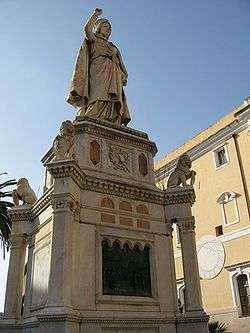
Broken the alliance with the Crown of Aragon, from 1353[51] to 1409, the Arborean giudici Marianus IV, Hugh III and Brancaleone Doria (husband of Eleanor of Arborea), succeeded in occupying all of Sardinia except the heavily fortified towns of the Castle of Cagliari and Alghero, which for years remained as the only Aragonese dominions in Sardinia.
In 1409, Martin I of Sicily, king of Sicily and heir to the crown of Aragon, defeated the Sardinians at the Battle of Sanluri. The battle was fought by about 20,000 Sardinian, Genoese and French knights, enrolled from their kingdom at a time when the population of Sardinia had been greatly depleted by the plague. Despite the Sardinian army outnumbering the Aragonese army, they were defeated.
The giudicato of Arborea disappeared in 1420, when its rights were sold by the last king for 100,000 gold florins,[52] and after some of its most notable men switched sides in exchange for privileges. For example, Leonardo Cubello, with some claim to the crown being from a family related to the Kings of Arborea, was granted the title of Marquis of Oristano and feudal rights on a territory that partly overlapped with the original extension of the Kingdom of Arborea in exchange for his subjection to the Aragonese monarchs.
The conquest of Sardinia by the Kingdom of Aragon meant the introduction of the feudal system throughout Sardinia. Thus Sardinia is probably the only European country where feudalism was introduced in the transition period from the Middle Ages to the early modern period, at a time when feudalism had already been abandoned by many other European countries.
Spanish period

In 1469, the heir to Sardinia, Ferdinand II of Aragon, married Isabel of Castile, and the "Kingdom of Sardinia" (which was separated from Corsica) was to be inherited by their Habsburg grandson, Charles I of Spain, with the state symbol of the Four Moors. The successors of Charles I of Spain, in order to defend their Mediterranean territories from raids of the Barbary pirates, fortified the Sardinian shores with a system of coastal lookout towers, allowing the gradual resettlement of some coastal areas.
The Kingdom of Sardinia remained Aragonese-Spanish for about 400 years, from 1323 to 1708, assimilating a number of Spanish traditions, customs and linguistic expressions, nowadays vividly portrayed in the folklore parades of Saint Efisio in Cagliari (1 May), the Cavalcade on Sassari (last but one Sunday in May), and the Redeemer in Nuoro (28 August). To this day Catalan is still spoken in the north-western city of Alghero (l'Alguer).
Many famines have been reported in Sardinia. According to Stephen L. Dyson and Robert J. Rowland, "The Jesuits of Cagliari recorded years during the late 16th century "of such hunger and so sterile that the majority of the people could sustain life only with wild ferns and other weeds" ... During the terrible famine of 1680, some 80,000 people, out of a total population of 250,000, are said to have died, and entire villages were devastated..."[53]
Savoyard period
In 1708, as a consequence of the Spanish War of Succession, the rule of the Kingdom of Sardinia passed from King Philip V of Spain into the hands of the Austrians, who occupied the island. The Treaty of Utrecht granted Sardinia to the Austrians, but in 1717, Cardinal Giulio Alberoni, minister of Philip V of Spain, reoccupied Sardinia.
In 1718, with the Treaty of London, Sardinia was handed over to the House of Savoy, that would impose the Italian language on the island in 1760.[54][55][56]
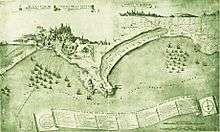
In 1793, Sardinians repelled two French invasions. On 23 February 1793, Domenico Millelire, commanding the Sardinian fleet, defeated the fleets of the French Republic near the Maddalena archipelago, of which then-lieutenant Napoleon Bonaparte was a leader.[57] Millelire became the first recipient of the Gold Medal of Military Valor of the Italian Armed Forces. In the same month, Sardinians stopped the attempted French landing on the beach of Quartu Sant'Elena, near the Capital of Cagliari. Because of these successes, the representatives of nobility and clergy (Stamenti) formulated five requests addressed to the King Victor Amadeus III of Sardinia, but they got refused. Because of this discontent, on 28 April 1794, during an uprising in Cagliari, two Savoyard officials were killed. That was the start of a revolt (called the "Sardinian Vespers") in the island, which culminated on 28 April 1794 (commemorated today as sa die de sa Sardigna) with the expulsion or even execution of the Piedmontese officers for a few days from the Capital Cagliari.

On 28 December 1795 in Sassari insurgents demonstrating against feudalism, mainly from the region of Logudoro, occupied the city. On 13 February 1796, in order to prevent the spread of the revolt, the viceroy Filippo Vivalda gave the Sardinian magistrate Giovanni Maria Angioy the role of Alternos, which meant a substitute of the viceroy himself. Angioy moved from Cagliari to Sassari, and during his journey almost all the villages joined the uprising, demanding an end to feudalism and aiming to declare the island to be an independent republic,[58][59] but once he was outnumbered by loyalist forces he fled to Paris and sought support for a French annexation of the island.
In 1798 the islet near Sardinia was attacked by the Tunisians and over 900 inhabitants were taken away as slaves.[60] The final Muslim attack on the island was on Sant'Antioco on 16 October 1815, over a millennium since the first.[61]
In 1799, as a consequence of the Napoleonic Wars in Italy, the Savoy royal family left Turin and took refuge in Cagliari for some fifteen years.[62] In 1847, the Sardinian parliaments (Stamenti), in order to get the Piedmontese liberal reforms they could not afford due to their separated legal system, renounced their state autonomy and agreed to form a union with Piedmont, Savoy, Nice and Liguria in order to have a single parliament, a single magistracy and a single government in Turin; this move aggravated the island's peripheral condition[63] and most of the pro-union supporters, including its leader Giovanni Siotto Pintor, would later regret it.[64]

In 1820, the Savoyards imposed the "Enclosures Act" (Editto delle Chiudende) on the island, aimed at turning the land's traditional collective ownership, a cultural and economic cornerstone of Sardinia since the Nuragic times,[65] to private property. This gave rise to many abuses, as the reform favoured the landholders while excluding the poor Sardinian farmers and shepherds, who witnessed the abolition of the communal rights and the sale of the land. Many local rebellions like the Nuorese Su Connottu ("The Already Known" in Sardinian) riot in 1868,[66][67] all repressed by the King's army, resulted in an attempt to return to the past and reaffirm the right to use the once common land. However the common lands (called ademprivios) were never completely abolished, and they are still present in large number to this day (500,000 hectares of common lands were counted in 1956, of which 345,000 constituted by woods).[68]
In 1848, the confederation of states powered by the Savoyard kings of Sardinia became a unitarian and constitutional state and moved to the Italian Wars of Independence for the Unification of Italy, that were led for thirteen years. In 1861, being Italy united by a debated war campaign, the parliament of the Kingdom of Sardinia decided by law to change its name and the title of its king in Kingdom of Italy and King of Italy. Most Sardinian forests were cut down at this time, in order to provide the Piedmontese with raw materials, like wood, used to make railway sleepers on the mainland. The extension of the primary natural forests, praised by every traveller visiting Sardinia, would in fact be reduced to 1/5 of their original number, being little more than 100.000 hectares at the end of the century.[69]
During the First World War, the Sardinian soldiers of the Brigata Sassari distinguished themselves. It was the first and only regional military unit in Italy, since the people enrolled were only Sardinians. The brigade suffered heavy losses and earned four Gold Medals of Military Valor. Sardinia lost more young people than any other Italian region on the front, with 138 casualties per 1000 soldiers compared to the Italian average of 100 casualties.
During the Fascist period, with the implementation of the policy of autarky, several swamps around the island were reclaimed and agrarian communities founded. The main communities were the village of Mussolinia (now called Arborea), populated by farmers from Veneto and Friuli, in the area of Oristano and Fertilia, populated at first by settlers from the Ferrara area, followed, after World War II, by a notable number of Istrian Italians and Dalmatian Italians hailing from territories lost to Yugoslavia, in the area adjacent the city of Alghero, within the region of Nurra . Also established during that time (1938) was the city of Carbonia, which became the main centre of coal mining activity, that attracted thousand of workers from the rest of the Island and the Italian mainland. The Sardinian writer Grazia Deledda won the Nobel Prize for Literature in 1926.
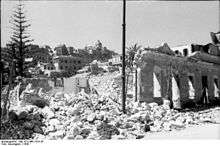
During the Second World War, Sardinia was an important air and naval base and was heavily bombed by the Allies, especially the city of Cagliari. German troops left the island on 8 September 1943, a few days after the Armistice of Cassibile, and retired to Corsica without fighting and bloodshed, after a bilateral agreement between the general Antonio Basso (Commander of the Armed Forces of Sardinia) and the German Karl Hans Lungerhausen, general of the 90th Panzergrenadier Division.[70]
Post-Second World War period
In 1946, by popular referendum, Italy became a republic, with Sardinia being administered since 1948 by a special statute of autonomy. By 1951, malaria was successfully eliminated by the ERLAAS, Anti-malaric Regional Authority, and the support of the Rockefeller Foundation, which facilitated the commencement of the Sardinian tourist boom.[71] With the increase in tourism, coal decreased in importance but Sardinia followed the Italian economic miracle.

In the early 1960s, an industrialisation effort was commenced, the so-called Piani di Rinascita (rebirth plans), with the initiation of major infrastructure projects on the island. These included the construction of new dams and roads, reforestation, agricultural zones on reclaimed marshland, and large industrial complexes (primarily oil refineries and related petrochemical operations). With the creation of petrochemical industries, thousands of ex-farmers became industrial workers. The 1973 oil crisis caused the termination of employment for thousands of workers employed in the petrochemical industries, which aggravated the emigration already present in the 1950s and 1960s.
Sardinia faced the creation of military bases on the island,[72][73] like Decimomannu Air Base and Salto di Quirra (the biggest scientific military base in Europe) in the same decades.[74] Even now, around 60% of all Italian and NATO military installations in Italy are on Sardinia, whose area is less than one-tenth of all the Italian territory and whose population is little more than the 2.5%;[75] furthermore, they comprise over 35.000 hectares used for experimental weapons testing,[76][77] where 80% of the military explosives in Italy are used.[78]
Sardinian nationalism and local protest movements became stronger in the 1970s, and a number of bandits (anonima sarda) started a long series of kidnappings, which ended only in the 1990s.[79] This also gave rise to various militant groups that blended separatist and communist ideas, the most famous being Barbagia Rossa and the Sardinian Armed Movement,[80] which perpetrated several bombings and terrorist actions between the 1970s and the 1980s.[81][82][83] In the span of just two years (1987–1988), 224 bombing attacks were reported.[84]
._Emory_S._Land_is_the_only_forward_deployed_submarine_tender_in_the_Western_hemisphere.jpg)
In 1983 a prominent activist of a separatist party, the Sardinian Action Party (Partidu Sardu – Partito Sardo d'Azione), was elected president of the regional parliament, and in the 1980s several other movements calling for independence from Italy were born; in the 1990s some of them became political parties, even if in a rather disjointed manner. It was not until 1999 that the island's languages (Sardinian, Sassarese, Gallurese, Algherese and Tabarchino) were recognised, even if just formally, together with Italian. The 35th G8 summit was planned by Prodi II Cabinet to be held in Sardinia, on the island of La Maddalena, in July 2009; however, in April 2009, the Italian Prime Minister, Silvio Berlusconi, decided, without convoking the Italian parliament or consulting the Sardinian governor of his own party, to move the summit, even though the works were almost completed, to L'Aquila, provoking heavy protests.
Today Sardinia is phasing in as an EU region, with a diversified economy focused on tourism and the tertiary sector. The economic efforts of the last twenty years have reduced the handicap of insularity, especially in the fields of low-cost air travel and advanced information technology. For example, the CRS4 (Center for Advanced Studies, Research and Development in Sardinia) developed the second European website and 1st in Italy in 1991[85] and webmail in 1995. CRS4 allowed several telecommunication companies and internet service providers based on the island to flourish, such as Videonline in 1994, Tiscali in 1998 and Andala Umts in 1999.
Education
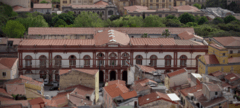
According to the ISTAT census of 2001, the literacy rate in Sardinia among people below 64 years old is 99.5 percent. Total literacy rate (including people over 65) is 98.2 percent.[86][87] Illiteracy rate among males below 65 years old is 0.24 percent and among women 0.25 percent;[86] the number of women that annually graduate at secondary high schools and universities is about 10–20 percent higher than men.[88][89] Sardinia has the 2nd highest rate of school drop-out in Italy.[90]
Sardinia has two public universities: the University of Sassari and the University of Cagliari, founded in the 17th century. 48,979 students were enrolled at universities in 2007–08.[91]
Economy
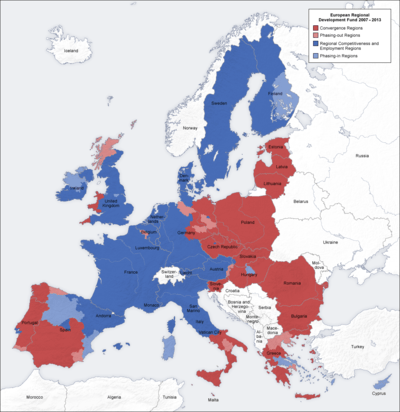

Taken as a whole, Sardinia's economic conditions are such that the island is in the best position among Italian regions located south of Rome. The greatest economic development had taken place inland, in the provinces of Cagliari and Sassari, characterized by a certain amount of enterprise. According to Eurostat, the 2014 nominal GDP was €33,356 million, €33,085 million in purchasing power parity, resulting in €19,900 GDP per capita that is the 72% of the EU average. The per capita income in Sardinia is the highest of the southern half of Italy. The most populated provincial chief towns have higher incomes: in Cagliari the income per capita is €27,545, in Sassari €24,006, in Oristano €23,887, in Nuoro is €23,316 and in Olbia is €20,827.[92]
The Sardinian economy is, however, constrained due to the high costs of the transportation of goods and electricity, which is twice that of the continental Italian regions, and triple that of the EU average. Sardinia is the only Italian region that produces a surplus of electricity, and exports electricity to Corsica and the Italian mainland: in 2009, the new submarine power cable Sapei entered into operation, it links the Fiume Santo Power Station, in Sardinia, to the converter stations in Latina, in the Italian peninsula, the SACOI is another submarine power cable that links Sardinia to Italy, crossing Corsica, from 1965. The submarine gas pipeline GALSI would have brought Algerian gas to the Italian mainland through the island.
Three main banks are headquartered in Sardinia: the Banco di Sardegna and the Banca di Sassari, both based in Sassari; Banca di Credito Sardo, based in Cagliari, was absorbed by parent company Intesa Sanpaolo in 2014.
The unemployment rate for the fourth quarter of 2008 was 8.6%; by 2012, the unemployment rate had increased to 14.6%.[93] Its rise was due to the global financial crisis that hit Sardinian exports, mainly focused on refined oil, chemical products, and also mining and metallurgical products.
There are chances for Sardinia to become a tax haven, the whole island territory being free by custom duties, vat and excise taxes on fuel; since February 2013, the town of Portoscuso has become the first free trade zone.[94][95][96][97][98][99] According to the article 12 of the Sardinian Statute modified by the regional parliament in October 2013: "The Territory of the Autonomous Region of Sardinia is located off the customs line and constitutes a Free Trade Zone enclosed by the surrounding sea; the access points consist of the seaports and the airports. The Sardinian Free Trade Zone is regulated by the laws of the European Union and Italy that are in force also in Livigno, Campione D'Italia, Gorizia, Savogna d'Isonzo and the Region of Aosta Valley".
| 2000 | 2001 | 2002 | 2003 | 2004 | 2005 | 2006 | 2007 | |
|---|---|---|---|---|---|---|---|---|
| Gross domestic product nominal (Million €) | 25,958.1 | 27,547.6 | 28,151.6 | 29,487.3 | 30,595.5 | 31,421.3 | 32,579.0 | 33,823.2 |
| GDP per capita nominal (Euro) | 15,861.0 | 16,871.4 | 17,226.5 | 17,975.7 | 18,581.0 | 19,009.8 | 19,654.3 | 20,444.1 |
Economic sectors

This table shows the sectors of the Sardinian economy in 2011:[100]
| Economic activity | GDP (mil. €) | % sector |
|---|---|---|
| Agriculture, farming, fishing | 908 | 3% |
| Industry | 2,828 | 9.4% |
| Constructions | 1,722 | 5.7% |
| Commerce, hotels and restaurants, transport, services and (tele)communications | 7,597 | 25.4% |
| Financial activity and real estate | 8,011 | 26.7% |
| Other economic activities related to services | 8,896 | 29.7% |
| Total value added | 29,962 | 100% |
| GDP of Sardinia | 33,638 |
Primary
Sardinia's land is dedicated 60% to livestock, 20% to agriculture and the rest is occupied by closed forests, urban areas and areas that are not exploitable. Sicily practically has reversed percentages and, with the same extension, almost three times the inhabitants of Sardinia. Sardinia is home to nearly 4 million sheep,[101] almost half of the entire Italian assets and that makes the island one of the areas of the world with the highest density of sheep along with some parts of UK and New Zealand (135 sheep every square kilometer versus 129 in UK and 116 in New Zealand). The soils of Sardinia are largely underpowered, shallow and therefore not very productive for agriculture. Sardinia has been for thousands of years specializing in sheep breeding, and, to a lesser extent, goats and cattle that is less productive of agriculture in relation to land use. It is probably in breeding and cattle ownership the economic base of the early proto-historic and monumental Sardinian civilization from Neolithic to the Iron Age.

Even agriculture has played a very important role in the economic history of the island, especially in the great plain of Campidano, particularly suitable for wheat farming. The Sardinian soils, even those plains are slightly permeable, with aquifers of lacking and sometimes brackish water and very small natural reserves. Water scarcity was the first problem that was faced for the modernization of the sector, with the construction of a great barrier system of dams, which today contains nearly 2 billion cubic meters of water.[102] The Sardinian agriculture is now linked to specific products such as cheese, wine, olive oil, artichoke, tomato for a growing product export. The reclamations have helped to extend the crops and to introduce other ones such as vegetables and fruit, next to the historical ones, olive and grapes that are present in the hilly areas. The Campidano plain, the largest lowland Sardinian produces oats, barley and durum, of which is one of the most important Italian producers. Among the vegetables, as well as artichokes, has a certain weight the production of oranges, and, before the reform of the sugar sector from the European Union, the cultivation of sugar beet. In the forests there is the cork oak, which grows naturally; Sardinia produces about 80% of Italian cork. In fresh food, as well as artichokes, the production of tomatoes (including Camoni tomato) and citrus fruit are of a certain weight. Sardinia is the 5th Italian region for rice production, the main paddy fields are located in the Arborea Plain.[103]
In addition to meat, Sardinia produces a wide variety of cheese, considering that half of the sheep milk produced in Italy is produced in Sardinia, and is largely worked by the cooperatives of the shepherds and small industries.[104] Sardinia also produces most of the pecorino romano, a non-original product of the island, much of which is traditionally addressed to the Italian overseas communities. Sardinia boasts a centuries-old tradition of horse breeding since the Aragonese domination, whose cavalry drew from equine heritage of the island to strengthen their own army or to make a gift to the other sovereigns of Europe.[105] Today the Island boasts the highest number of horse herds in Italy.[106]
There is little fishing (and no real maritime tradition), Portoscuso tunas are exported worldwide, but primarily to Japan. The cork district, in the northern part of the Gallura region, around Calangianus and Tempio Pausania, is composed of 130 companies. Every year in Sardinia 200,000 quintals (20,000 tonnes) of cork are carved, and 40% of the end products are exported.
Industry and handicraft
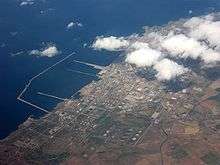
The once prosperous mining industry is still active though restricted to coal (Nuraxi Figus, hamlet of Gonnesa),[107] antimony (Villasalto), gold (Furtei), bauxite (Olmedo) and lead and zinc (Iglesiente, Nurra). The granite extraction represents one of the most flourishing industries in the northern part of the island. The Gallura granite district is composed of 260 companies that work in 60 quarries, where 75% of the Italian granite is extracted. The principal industries are chemicals (Porto Torres, Cagliari, Villacidro, Ottana), petrochemicals (Porto Torres, Sarroch), metalworking (Portoscuso, Portovesme, Villacidro), cement (Cagliari), pharmaceutical (Sassari), shipbuilding (Arbatax, Olbia, Porto Torres), oil rig construction (Arbatax), rail industry (Villacidro),[108][109] arms industries at Domusnovas[110][111] and food (sugar refineries at Villasor and Oristano, dairy at Arborea, Macomer and Thiesi, fish factory at Olbia.
In Sardinia is located the DASS (Distretto Aerospaziale della Sardegna), a consortium of companies, research centers and universities focused on aerospace industry and research.[112][113][114] The aerospace manufacturer Vitrociset, in Villaputzu, is involved in the production of the stealth multirole fighter Lockheed Martin F-35 Lightning II.[115][116]
Plans related to industrial conversion are in progress in the main industrial sites, like in Porto Torres, where seven research centres are developing the transformation from traditional fossil fuel related industry to an integrated production chain from vegetable oil using oleaginous seeds to bio-plastics.matrica green chemicals[117][118]
Sardinia is involved in the industrial production of the AIRPod, an innovative car powered by compressed air, with the first factory being built in Bolotana.[119][120][121][122]
Craft industries include rugs, jewelry, textile, lacework, basket making and coral.
Tertiary
The Sardinian economy is today focused on the overdeveloped tertiary sector (67.8% of employment), with commerce, services, information technology, public administration and especially on tourism (mainly balnear tourism), which represents the main industry of the island with 2,721 active companies and 189,239 rooms. In 2008 there were 2,363,496 arrivals (up 1.4% on 2007). In the same year, the airports of the island registered 11,896,674 passengers (up 1.24% on 2007).[123]
Communications
On the island are headquartered some telecommunication companies and internet service providers, such as Tiscali and the Mediterranean Skylogic Teleport, a ground station controlled by satellite provider Eutelsat.[124] Sardinia is after Valle D'Aosta the Italian region with the highest e-intensity index[125][126] (Index that measures the relative maturity of Internet economies on the basis of three factors: enablement, engagement, and expenditure) and the region with the highest internet performances, such as fastest broadband connection in Italy.[127]The Chinese multinational telecommunications equipment and systems companies ZTE and Huawei have development centers and innovation labs in Sardinia.[128][129]
Sardinia has become Europe's first region to fully adopt the new Digital Terrestrial Television broadcasting standard. From 1 November 2008 TV channels are broadcast only in digital.[130]
Transport
Airports
.jpg)
Sardinia has three international airports (Alghero-Fertilia/Riviera del Corallo Airport, Olbia-Costa Smeralda Airport and Cagliari-Elmas Airport) connected with the principal Italian cities and many European destinations, mainly in the United Kingdom, Scandinavia, Spain and Germany, and two regional airports (Oristano-Fenosu Airport and Tortolì-Arbatax Airport). Internal air connections between Sardinian airports are limited to a daily Cagliari-Olbia flight and Tortolì-Olbia flight.[131] Sardinian citizens benefit from special sales on plane tickets, and several low-cost air companies operate on the island.
Meridiana is an airline based in the airport of Olbia; it was founded as Alisarda in 1963 by the Aga Khan IV. The development of Alisarda followed the development of Costa Smeralda in the north east part of the island, a well known vacation spot among billionaires and film actors worldwide.
Seaports
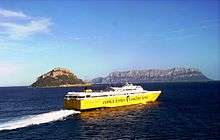
The ferry companies operating on the island are Tirrenia di Navigazione, Moby Lines, Corsica Ferries - Sardinia Ferries, Grandi Navi Veloci, SNAV, SNCM and CMN; they link the Sardinian seaports of Porto Torres, Olbia, Golfo Aranci, Arbatax, Santa Teresa Gallura, Palau and Cagliari with Civitavecchia, Genoa, Livorno, Naples, Palermo, Trapani, Piombino in Italy, Marseille, Toulon, Bonifacio, Propriano and Ajaccio in France and Barcelona in Spain.
A regional ferry company, the Saremar, links the main island to the islands of La Maddalena and San Pietro, and from 2011, also the port of Olbia with Civitavecchia and Porto Torres with Savona.
About 40 tourist harbours are located along the Sardinian coasts.
Roads
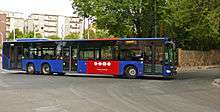
Sardinia is the only Italian region without Autostrade, but the road network is well developed with a system of no-toll roads with dual carriageway, called superstrade (en: super roads), that connect the principal towns and the main airports and seaports; the speed limit is 90 km/h (56 mph)/110 km/h (68 mph). The principal road is the SS131 "Carlo Felice", linking the north with the south of the island, crossing the most historic regions of Porto Torres and Cagliari; it is part of European route E25. The SS 131 d.c.n links Oristano with Olbia, crossing the hinterland Nuoro region. Other roads designed for high-capacity traffic link Sassari with Alghero, Sassari with Tempio Pausania, Sassari – Olbia, Cagliari – Tortolì, Cagliari – Iglesias, Nuoro – Lanusei. A work in progress is converting the main routes to highway standards, with the elimination of all intersections. The secondary inland and mountain roads are generally narrow with many hairpin turns, so the speed limits are very low.
Public transport buses reach every town and village at least once a day; however, due to the low density of population, the smallest territories are reachable only by car. The Azienda Regionale Sarda Trasporti (ARST) is the public regional bus transport agency. Networks of city buses serve the main towns.
In Sardinia 1,295,462 vehicles circulate, equal to 613 per 1,000 inhabitants.[132]
Railways
.jpg)
The Sardinian railway system was developed starting from the 19th century by the Welsh engineer Benjamin Piercy.
Today there are two different railway operators:
- Trenitalia which connects the most populated towns, the main ports and also the Italian peninsula through the use of train ferries. This network is the most modern on the island, running primarily diesel locomotives such as the Alstom Minuetto and, from 2015 the faster tilting train CAF ATR365 and ATR 465, specifically designed for the Sardinian railway network;[133]
- ARST: the trains run on narrow-gauge track, are generally slow, due to the tortuosity of the lines, except for the electrified tram-trains operating in the metropolitan areas of Sassari and Cagliari.
The Trenino Verde (Little Green Train) is a railway tourism service operated by ARST. Vintage railcars and steam locomotives run through the wildest parts of the island. They allow the traveller to have scenic views impossible to see from the main roads.
Demographics
| Historical population | ||
|---|---|---|
| Year | Pop. | ±% |
| 1485 | 157,578 | — |
| 1603 | 266,676 | +69.2% |
| 1678 | 299,356 | +12.3% |
| 1688 | 229,532 | −23.3% |
| 1698 | 259,157 | +12.9% |
| 1728 | 311,902 | +20.4% |
| 1751 | 360,805 | +15.7% |
| 1771 | 360,785 | −0.0% |
| 1776 | 422,647 | +17.1% |
| 1781 | 431,897 | +2.2% |
| 1821 | 461,931 | +7.0% |
| 1824 | 469,831 | +1.7% |
| 1838 | 525,485 | +11.8% |
| 1844 | 544,253 | +3.6% |
| 1848 | 554,717 | +1.9% |
| 1857 | 573,243 | +3.3% |
| 1861 | 609,000 | +6.2% |
| 1871 | 636,000 | +4.4% |
| 1881 | 680,000 | +6.9% |
| 1901 | 796,000 | +17.1% |
| 1911 | 868,000 | +9.0% |
| 1921 | 885,000 | +2.0% |
| 1931 | 984,000 | +11.2% |
| 1936 | 1,034,000 | +5.1% |
| 1951 | 1,276,000 | +23.4% |
| 1961 | 1,419,000 | +11.2% |
| 1971 | 1,474,000 | +3.9% |
| 1981 | 1,594,000 | +8.1% |
| 1991 | 1,648,000 | +3.4% |
| 2001 | 1,632,000 | −1.0% |
| 2011 | 1,639,362 | +0.5% |
| 2017 | 1,653,135 | +0.8% |
| Source: ISTAT 2011, – D.Angioni-S.Loi-G.Puggioni, La popolazione dei comuni sardi dal 1688 al 1991, CUEC, Cagliari, 1997 – F. Corridore, Storia documentata della popolazione di Sardegna, Carlo Clausen, Torino, 1902 | ||
With a population density of 69/km2, slightly more than a third of the national average, Sardinia is the fourth least populated region in Italy. In the recent past the population distribution was anomalous compared to that of other Italian regions lying on the sea. In fact, contrary to the general trend, most urban settlement, with the exception of the fortified cities of Cagliari, Alghero, Castelsardo and few others, has not taken place primarily along the coast but in the subcoastal areas and towards the centre of the island. Historical reasons for this include the repeated Saracen raids during the Middle Ages and then Barbary raids until the early 19th century (making the coast unsafe), widespread pastoral activities inland, and the swampy nature of the coastal plains (reclaimed definitively only in the 20th century). The situation has been reversed with the expansion of seaside tourism; today all Sardinia's major urban centres are located near the coasts, while the island's interior is very sparsely populated.
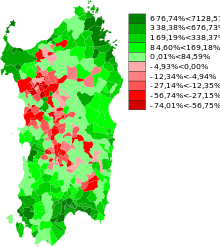
It is the region with the lowest total fertility rate[134] (1.087 births per woman) and the second-lowest birth rate of Italy[135] (which is already one of the lowest in the world). Combined with the aging of population going rather fast (in 2009, people older than 65 were 18,7%), rural depopulation is quite a big issue: between 1991 and 2001, 71,4% of Sardinian villages have lost population (32 more than 20% and 115 between 10% and 20%), with over 30 of them being at risk to become ghost towns.[136] Nonetheless, the overall population has been increasing because of a considerable immigration flow, mainly from the Italian mainland, Eastern Europe (esp. Romania), Africa and Asia.
Life expectancy
Average life expectancy is slightly over 82 years (85 for women and 79.7 for men [137] ). Sardinia shares with the Japanese island of Okinawa the highest rate of centenarians in the world (22 centenarians/100,000 inhabitants). Sardinia is the first discovered Blue Zone, a demographic and/or geographic area in the world with an oversize concentration of centenarians and supercentenarians.
Foreign immigration
In 2016 there were 50,346 foreign national residents, forming 3% of the total Sardinian population.[138] The most represented nationalities were[138]:
|
Main cities and Functional Urban Areas

Sardinia's most populated cities are Cagliari and Sassari. The Metropolitan City of Cagliari has 431,302 inhabitants, or about ¼ of the population of the entire island. Eurostat has identified in Sardinia two Functional Urban Areas:[139] Cagliari, with 477,000 inhabitants, and Sassari, with 222,000 inhabitants.
| Rank | Commune | Province | Population[140] | Density (inh./km2) |
|---|---|---|---|---|
| 1st | Cagliari | Metropolitan City of Cagliari | 154,460 | 1,805 |
| 2nd | Sassari | Province of Sassari | 127,525 | 230 |
| 3rd | Quartu Sant'Elena / Quartu Sant'Aleni[141] | Metropolitan City of Cagliari | 71,125 | 719 |
| 4th | Olbia | Province of Sassari | 59,368 | 146 |
| 5th | Alghero / L'Alguer | Province of Sassari | 44,019 | 181 |
| 6th | Nuoro / Nùgoro | Province of Nuoro | 37,091 | 189 |
| 7th | Oristano / Aristanis | Province of Oristano | 31,630 | 380 |
| 8th | Carbonia | Province of South Sardinia | 28,755 | 197 |
| 9th | Selargius / Ceraxius[141] | Metropolitan City of Cagliari | 28,975 | 1092 |
| 10th | Iglesias | Province of South Sardinia | 27,189 | 133 |
| 11th | Assemini / Assèmini[141] | Metropolitan City of Cagliari | 26,686 | 238 |
| 12th | Capoterra / Cabuderra[141] | Metropolitan City of Cagliari | 23,861 | 349 |
| 13th | Porto Torres | Province of Sassari | 22,313 | 218 |
| 14th | Sestu[141] | Metropolitan City of Cagliari | 20,454 | 423 |
| 15th | Monserrato / Pauli[141] | Metropolitan City of Cagliari | 20,055 | 3,180 |
Government and politics
.svg.png)
Sardinia is one of the five Italian autonomous regions, along with Valle d'Aosta, Trentino-Alto Adige/Südtirol, Friuli Venezia Giulia and Sicily. Its statute, which is a constitutional law, gives the region the right to create its own laws in a wide number of domains and to carry out regional administrative functions.
The regional administration is constituted by three authorities:
- the Regional Council (legislative power)
- the Regional Junta (executive power)
- the President (chief of executive power)
Administrative divisions
Sardinia is divided into four provinces, Nuoro, Oristano, Sassari and South Sardinia, and one metropolitan city, Cagliari.
| Province | Area (km2) | Population | Density (inh./km2) |
|---|---|---|---|
| Cagliari (metropolitan city) | 1,248 | 431,568 | 345.8 |
| Province of Nuoro | 5,786 | 213,206 | 36.8 |
| Province of Oristano | 3,034 | 160,864 | 53.0 |
| Province of Sassari | 7,692 | 494,388 | 64.2 |
| Province of South Sardinia | 6,339 | 358,229 | 56.5 |
Military installations
_(22126481703).jpg)
Around 61% of all the Italian and NATO military installations in Italy are on Sardinia, whose area is less than one-tenth of all the Italian territory and whose population is little more than the 2,5%. The bases, used for manufacturing plants and military testing grounds, totally take up more than 350 km² of the island's land,[142] making Sardinia the most militarized region in Italy and the most militarized island in Europe.[143] Besides the land-occupying installations, where 80% of the military explosives in Italy are used,[78] there are also other military structures located on the sea and along the coastline, roughly equivalent to 20000 km² (little less than the island's surface), being made inaccessible to the civil population when military exercises are being held.[142] Among the others, the most notable military bases on the island are the Interagency Polygons in Quirra, Capo Teulada and Capo Frasca, used by Italian and NATO forces to test-fire ballistic missiles and weapons. Until 2008, the US navy had also a nuclear submarine base in the Maddalena Archipelago.[142][73]
Culture
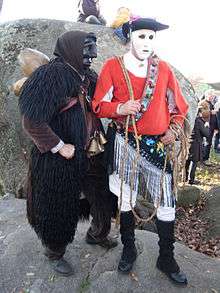
Sardinia is the only autonomous region where its special Statute uses the term popolo (distinct people) to describe its inhabitants. While this formula applies even to Veneto, which unlike Sardinia is an ordinary region within the Italian Republic, the Sardinian Statute is adopted with a constitutional law. In both cases, this term does not imply any legal difference between Sardinians and the other Italian citizens.
Languages
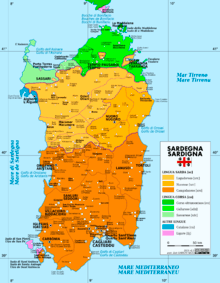
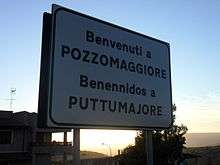
Italian (Italiano), which is the official language throughout Italy, is the most widely spoken language on the island, followed by Sardinian (Sardu).[144]
Sardinian is a distinct branch of the Romance language family: it is not, by any means, an Italian dialect,[145] rather it is closer to its Latin roots than Italian itself.[146] Sardinian has been formally recognized as one of the twelve historical language minorities of Italy since 1997, by regional and Italian law.[147][148] The language has been influenced by Catalan, Spanish and recently Italian, while the once spoken Nuragic contributes many features to it in many ancient remnants. In 2006 the regional administration has approved the use of a standardised writing system, the so-called Limba Sarda Comuna,[149] in official acts. As a literary language, Sardinian is gaining importance, despite heated debate about the lack of a commonly acknowledged standard orthography and controversial proposed solutions to this problem.[150]
The two most widely spoken forms of the language are the Southern dialects, known as Campidanese (Sardu Campidanesu), and the Northern dialects known as Logudorese (Sardu Logudoresu), extending almost to the suburbs of Sassari. The Sardinian language is quite different from the other Romance languages and is homogeneous in terms of morphology, syntax and lexicon, but it also shows a spectrum of variation in terms of phonetics between the Northern and the Southern dialects.
Sassarese (Sassaresu) and Gallurese (Gadduresu) are classified as Corso-Sardinian languages, therefore more akin to the Italo-Dalmatian branch than to the Sardinian one, and are spoken in the north.
In Sardinia there are examples of language islands: Algherese (Alguerés) is a dialect of Catalan spoken in the city of Alghero; on the islands of San Pietro and Sant'Antioco, located in the extreme south west of Sardinia, the local population speaks a variant of Ligurian called Tabarchino (Tabarchin); fewer and fewer people speak Venetian, Friulian and Istriot in Arborea and Fertilia, since these villages have been populated in the 1920s and 1930s by colonists who mainly came from north-eastern Italy, and families from Istria and Dalmatia immediately after World War II.
Due to the Italian assimilation policies carried out since 1760[151] and the ongoing absorption into the Italian culture, over the course of time the once prevalent indigenous languages have been increasingly losing ground to Italian and the process of ongoing language shift has led to their extreme endangerment.[152] In fact, according to the data published by ISTAT in 2006,[153] 52.5% of the Sardinian population mainly speaks Italian in the family environment, while 29.3% alternates Italian and Sardinian and only 16.6% mainly uses Sardinian or other non-Italian languages.
Following the recent growth of the foreign-born population, the presence of other languages, principally Romanian, Arabic, Wolof and Chinese, is expanding in some urban areas.
World Heritage Sites
Megalithic building structures called nuraghes are scattered in great numbers throughout Sardinia. Su Nuraxi di Barumini is a UNESCO World Heritage Site.[154]
Literature
Traditional clothes

Colourful and of various and original forms, the Sardinian traditional clothes are a clear symbol of belonging to specific collective identities. Although the basic model is homogeneous and common throughout the island, each town or village has its own traditional clothing which differentiates it from the others.
Music
Sardinia is home to one of the oldest forms of vocal polyphony, generally known as cantu a tenore. In 2005, Unesco classed the cantu a tenore among intangible world heritage. Several famous musicians have found it irresistible, including Frank Zappa, Ornette Coleman, and Peter Gabriel. The latter travelled to the town of Bitti in the central mountainous region and recorded the now world-famous Tenores di Bitti CD on his Real World label. The guttural sounds produced in this form make a remarkable sound, similar to Tuvan throat singing. Another polyphonic style of singing, more like the Corsican paghjella and liturgic in nature, is found in Sardinia and is known as cantu a cuncordu.
Another unique instrument is the launeddas. Three reed-canes (two of them glued together with beeswax) produce distinctive harmonies, which have their roots many thousands of years ago, as demonstrated by the bronze statuettes from Ittiri, of a man playing the three reed canes, dated to 2000 BC.
Beyond this, the tradition of cantu a chiterra (guitar songs) has its origins in town squares, when artists would compete against one another. The most famous singer of this genre are Maria Carta and Elena Ledda.
Sardinian culture is alive and well, and young people are actively involved in their own music and dancing. In 2004, BBC presenter Andy Kershaw travelled to the island with Sardinian music specialist Pablo Farba and interviewed many artists. His programme can be heard on BBC Radio 3. Sardinia has produced a number of notable jazz musicians such as Antonello Salis, Marcello Melis, and Paolo Fresu.
The main opera houses of the island are the Teatro Lirico in Cagliari and the Teatro Verdi in Sassari (soon to be replaced by the new Teatro Auditorium Comunale).
Cuisine
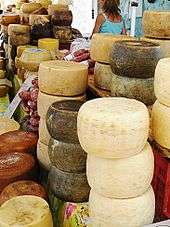

Meat, dairy products, grains and vegetables constitute the most basic elements of the traditional diet, to a lesser extent rock lobster (aligusta), scampi, bottarga (butàriga), squid, tuna.
Suckling pig (porcheddu) and wild boar (sirbone) are roasted on the spit or boiled in stews of beans and vegetables, thickened with bread. Herbs such as mint and myrtle are used. Much Sardinian bread is made dry, which keeps longer than high-moisture breads. Those are baked as well, including civraxiu, coccoi pintau, a highly decorative bread and pistoccu made with flour and water only, originally meant for herders, but often served at home with tomatoes, basil, oregano, garlic and a strong cheese.[155] Traditional cheeses include pecorino sardo, pecorino romano, casizolu, ricotta and the casu marzu (notable for containing live insect larvae).
One of the most famous of foods is pane carasau, the flat bread of Sardinia, famous for its thin crunchiness.[156] Originally the making of this bread was a hard process which needed three women to do the job. This flat bread is always made by hand as it gives a different flavor the more you work the dough. After working the dough it will be rolled out in very thin circles and placed in an extremely hot stone oven where the dough will blow up into a ball shape. Once the dough achieves that state it is then removed from the oven where it is then cut into two thin sheets and stacked to go back into the oven.[157]
Alcoholic beverages include many peculiar wines such as Cannonau, Malvasia, Vernaccia, Vermentino, various liquors like Abbardente, Filu Ferru and Mirto. Beer is the most drunk alcoholic beverage, Sardinia boasts the highest consumption per capita of beer in Italy (twice higher than national average).[158] Birra Ichnusa is the most commercialized beer produced in Sardinia.
Sports
Football

Cagliari is home to Cagliari Calcio, which was founded in 1920 and will play in the Serie A, the Italian first division, in 2016–17 following promotion from Serie B. It won the Italian Championship in the 1969–70 Serie A season, becoming the first club in Southern Italy to achieve such a result. Home matches are played at the Stadio Sant'Elia.
Basketball
Sassari is home to Dinamo Basket Sassari, the only Sardinian professional basketball club playing in the Italiana serie A (Lega A), the highest level club competition in Italian professional basketball. It was founded in 1960, and is also known as Dinamo Banco di Sardegna thanks to a long sponsorship deal with the Sardinian bank. Since its promotion in Lega A in 2010, it has been enjoying the support of fans from Sassari and all over Sardinia with full-house matches on every game played at home. Dinamo Sassari achieved the highest titles in the Italian basketball in 2015, winning the Coppa Italia, the Supercoppa and the Italian basketball championship.[159]
Motor racing

In the Province of Sassari is the Mores motor racing circuit, the only FIA Circuit homologated by CSAI (Cars) and the IMF (Motorcycles), in Sardinia.
Cagliari hosted a Formula 3000 race in 2002 and 2003 on a 2.414-km street circuit around Sant'Elia stadium. In 2003, Renault F1's Jarno Trulli and former Ferrari driver Jean Alesi did a spectacular exhibition. At the Grand Prix BMW-F1 driver Robert Kubica took part in a F3 car, as did BMW WTCC Augusto Farfus, GP2's Fairuz Fauzy and Vitaly Petrov. Since 2004 Sardinia has hosted the Rally d'Italia Sardegna, a rally competition in the FIA World Rally Championship schedule. The rally is held on narrow, twisty, sandy and bumpy mountainous roads in the north of the island.
Water sports
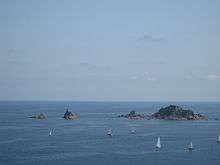
On the island of Caprera is located the Centro Velico Caprera, that is considered the largest school of sailing in the Mediterranean Sea, founded in 1967.
The Yacht Club Costa Smeralda located in Porto Cervo and founded in 1967 is the main yachting club in the island.
Annually the island hosts the Loro Piana Super Yacht Regatta and the Maxy Yacht Rolex Cup. Part of the Louis Vuitton Trophy was held in the Maddalena archipelago in 2010.
Cagliari hosts regular international regattas, such RC44 championship, Farr 40 World championship and Audi MedCup; all series which boast current America's Cup contenders like BMW Oracle Racing, Mascalzone Latino and Emirates Team New Zealand as contenders.
Vento di Sardegna (en: Wind of Sardinia) is a sailboat sponsored by the Autonomous Region of Sardinia. Its skipper, Andrea Mura, won the Single-Handed Trans-Atlantic Race in 2013, the Two Handed Transatlantic Race (Twostar) regatta in 2012 and the Route du Rhum.
Porto Pollo, north of Palau, is a bay often used by windsurfers and kitesurfers. The bay is divided by a thin tongue of land that separates it in an area for advanced and beginning/intermediate windsurfers. There is also a restricted area for kitesurfers. Many Italian freestyle surfers come to Porto Pollo for training and 2007 saw the finale of the freestyle pro kids Europe 2007 contest. Because of the Venturi effect between Sardinia and Corsica, western wind accelerates between the islands and creates the wind that makes Porto Pollo popular among windsurfing enthusiasts. In 2005, Aglientu, hosted the Kitesurf World Cup in the Vignola's beach.
Winter sports
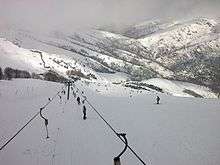
Four ski resorts are located on the Gennargentu Range at Separadorgiu, Monte Spada, S'Arena and Bruncu Spina, they are equipped with ski schools, skilifts and ski equipment hire.[160]
Traditional sports
S'Istrumpa, also known as Sardinian Wrestling, is a traditional Sardinian sport, officially recognized by the Italian National Olympic Committee (C.O.N.I.) and the International Federation of Celtic Wrestling (I.F.C.W.).[161] It shows similarities with the Scottish Backhold and the gouren. Istrumpa's wrestlers participate annually at the championships for Celtic wrestling stiles.
Sardinia boasts ancient equestrian traditions and is the Italian region with the highest number of horse riders (29% of population)[162] and boasts also fine darts tradition, which many believe originated in the Sassari region of the country towards the end of the 15th century. In those days, the darts were carved from beech (fagus) wood and the flights were feathers drawn from the indigenous pollo sultano (‘sultana bird’), famed for its spectacular violet-blue plumage.
Environment
The island has some environmental laws. Following an enormous reforestation plan it has become the Italian region with the largest forest extension. The 50% of the territory is covered by forested areas, 1,213,250 hectares (12,132 km2).[163][164] The Corpo forestale e di vigilanza ambientale della Regione Sarda is the Sardinian Forestry Corps. Sardinia is the Italian region most affected by forest fires during the summer.
The Regional Landscape Plan prohibits new building activities on the coast (except in urban centers), next to forests, lakes or other environmental or cultural sites and the Coastal conservation agency ensures the protection of natural areas on the Sardinian coast.
Renewable energies have increased noticeably in recent years,[165] mainly wind power, favoured by the windy climate, but also solar power (Carlo Rubbia, Nobelist in physics, is creating an experimental solar thermal energy central) and biofuel, based on jatropha oil and colza oil. 586.8 megawatts of wind power capacity were installed on the island at the end of 2009.[166]
Fauna


Sardinia is home to a wide variety of rare or uncommon animals, such as several species of mammals, many of them belonging to an endemic subspecies: the Mediterranean monk seal, Sarcidano horse, Giara horse, albino donkey, Sardinian feral cat, mouflon, Sardinian long-eared bat, Sardinian deer, fallow deer, Sardinian fox (Vulpes vulpes ichnusae), Sardinian hare (Lepus capensis mediterraneus), wild boar (Sus scrofa meridionalis), edible dormouse and European pine marten.
Rare amphibians, found only on the island, are the Sardinian brook salamander, brown cave salamander, imperial cave salamander, Monte Albo cave salamander, Supramonte cave salamander and Sarrabus cave salamander (Speleomantes sarrabusensis); the Sardinian tree frog is also found in Corsica and in the Tuscan Archipelago. Among reptiles worthy of note are Bedriaga's rock lizard, the Tyrrhenian wall lizard and Fitzinger's algyroides, endemic species of Sardinia and Corsica. The island is inhabited by terrestrial tortoises and sea turtles like Hermann's tortoise, the spur-thighed tortoise, marginated tortoise (Testudo marginata sarda), Nabeul tortoise, loggerhead sea turtle and green sea turtle. A new arachnid species, endemic to the island, has been recently found: the Nuragic spider.
Sardinia has four endemic subspecies of birds found nowhere else in the world: its great spotted woodpecker (ssp harterti), great tit (ssp ecki), common chaffinch (ssp sarda), and Eurasian jay (ssp ichnusae). It also shares a further 10 endemic subspecies of bird with Corsica. In some cases Sardinia is a delimited part of the species range. For example, the subspecies of hooded crow, Corvus cornix ssp cornix occurs in Sardinia and Corsica, but no further south.[168]
Some birds of prey found here are the griffon vulture, common buzzard, golden eagle, long-eared owl, western marsh harrier, peregrine falcon, European honey buzzard, Sardinian goshawk (Accipiter gentilis arrigonii), Bonelli's eagle and Eleonora's falcon, whose name comes from Eleonor of Arborea, national heroine of Sardinia, expert in falconry.[169] The hundreds of lagoons and coastal lakes that dot the island are home for many species of wading birds, such as the greater flamingo.
Conversely, Sardinia lacks many species common on the European continent, such as the viper, wolf, bear and marmot.
The island has also long been used for grazing flocks of indigenous Sardinian sheep. The Sardinian Anglo-Arab is a horse breed that was established in Sardinia, where it has been selectively bred for more than one hundred years.
Three different breeds of dogs are peculiar to Sardinia: the Pastore Fonnese, Dogo Sardo and Levriero Sardo.
Natural parks and reserves

Over 600,000 hectares of Sardinian territory is environmentally preserved[170][171] (about 25% of the island's territory). The island has three national parks:[172]
- 1. Asinara National Park,
- 2. Arcipelago di La Maddalena National Park, and
- 3. Gennargentu National Park.
- The numbers correspond to those in the map to right.
Ten regional parks:
- 4. Parco del Limbara
- 5. Parco del Marghine e Goceano
- 6. Parco del Sinis – Montiferru
- 7. Parco di Monte Arci
- 8. Parco della Giara di Gesturi
- 9. Parco di Monte Linas – Oridda – Marganai
- 10. Parco dei Sette Fratelli – Monte Genas
- 11. Parco del Sulcis
- Parco naturale regionale di Porto Conte
- Parco regionale Molentargius – Saline
There are 60 wildlife reserves, 5 W.W.F oases, 25 natural monuments and one Geomineral Park, preserved by UNESCO.[173]
Northern Sardinian Coasts are included in the Pelagos Sanctuary for Mediterranean Marine Mammals, a Marine Protected Area, that covers a surface of about 84,000 km2 (32,433 sq mi), aimed at the protection of marine mammals.
See also
- History of Sardinia
- List of tourist attractions in Sardinia
- Sardinian people, List of Sardinians
- Sardinian language
- Giudicati
- Kingdom of Sardinia
- Sardinian literature
- Sardinian Literary Spring
- List of monarchs of Sardinia
References
- Notes
- ↑ "Statistiche demografiche ISTAT 2011" (PDF). Demo.istat.it. Retrieved 4 December 2012.
- 1 2 http://www.bancaditalia.it/pubblicazioni/econo/ecore/2013/analisi_s-r/1321_sardegna/1321_sardegna.pdf Banca D'Italia, Economie regionali – Istat datas – page 55
- ↑ Delibera della Giunta regionale del 26 giugno 2012
- ↑ "Legge Regionale 15 ottobre 1997, n. 26-Regione Autonoma della Sardegna".
- ↑ Nuragica, Archeologia (9 August 2010). "Archeologia Nuragica: Sul nome Sardigna".
- ↑ Platonis dialogi, scholia in Timaeum (edit. C. F. Hermann, Lipsia 1877), 25 B, pag. 368
- ↑ M. Pittau, La Lingua dei Sardi Nuragici e degli Etruschi, Sassari 1981, pag. 57
- ↑ Sardi in Dizionario di Storia (2011), Treccani
- ↑ Sardi in Enciclopedia Italiana (1936), Giacomo Devoto, Treccani
- ↑ "Personaggi – Sardo".
- ↑ C.Michael Hogan. 2011. Balearic Sea. Encyclopedia of Earth. Eds. P.Saundry & C.J.Cleveland. National Council for Science and the Environment. Washington DC
- ↑ https://figshare.com/articles/Bioclimate_map_of_Sardinia_Italy_/1263959
- ↑ http://www.earthweek.com/2013/ew131122/ew131122c.html Cyclone' Cleopatra Submerges Parts of Sardinia
- ↑ "Località più secche". Sardegna Clima Onlus.
- ↑ Domenico Corraine. "Il clima della Sardegna".
- ↑ Tabelle climatiche 1971–2000 della stazione meteorologica di Cagliari-Elmas Ponente dall'Atlante Climatico 1971–2000 – Servizio Meteorologico dell'Aeronautica Militare
- ↑ "Climatological Information for Cagliari, Italy" – Hong Kong Observatory
- 1 2 Paolo Melis – Un approdo della costa di Castelsardo, fra età nuragica e romana
- ↑ Giovanni Ugas, L'alba dei Nuraghi p.22-23-24-25-29-30-31-32
- ↑ Nuraghes in Logudorese Sardinian, nuraxis in Campidanese Sardinian, plurals of nuraghe and nuraxi respectively.
- ↑ "SP INTERVISTA>GIOVANNI UGAS: SHARDANA".
- ↑ Claudian, De Bello Gildonico, IV A.D.: city located in front of Libya (Africa), founded by the powerful Tyro, Karalis extends in length, between the waves, with a small bumpy hill, disperses headwinds. It follows a port in the mid of the sea, and all strong winds are softened in the shelter of the pond.(521.Urbs Lybiam contra Tyrio fundata potenti 521. Tenditur in longum Caralis, tenuemque per undas 522. Obvia dimittit fracturum flamina collem. 523. Efficitur portus medium mare: tutaque ventis 524. Omnibus, ingenti mansuescunt stagna recessu)
- 1 2 Brigaglia, Mastino, Ortu 2006, p. 27.
- ↑ Piero Meloni, La Sardegna romana, Sassari, Chiarella, 1975, p. 4.
- ↑ "Sardinia - Province of the Roman Empire". www.unrv.com. Retrieved 2017-07-18.
- ↑ Casula 1994, p. 133.
- ↑ The Vandals by Andy Merrills and Richard Miles, published by John Wiley & Sons, 2010, p. 136. Retrieved 12 October 2010
- ↑ "Provicia del Sole – Siena".
- ↑ Casula 1994, p. 137-138.
- ↑ Italia, Stephan Hützen & MT Publisher. "Sardinia - History of Sardinia". www.sardegna.net. Retrieved 2017-07-18.
- ↑ Wolf Heinz J., 1998, Toponomastica barbaricina. Microtoponomastica dei comuni di Fonni, Gavoi, Lodine, Mamoiada, Oliena, Ollolai, Olzai, Orgósolo, Ovodda, Insula Edizioni
- ↑ Gregorius I, Epistolae, Liber Quartus, Epistola XXIII: “Ad Hospitonem ducem barbaricinorum: Gregorius Hospitoni duci Barbaricinorum. Cum de gente vestra nemo Christianus sit, in hoc scio quia omni gente tua es melior, quia tu in ea Christianus inveniris. Dum enim Barbaricini omnes, ut insensata animalia vivant, Deum verum nesciant, ligna autem et lapides adorent, in eo ipso quod Deum verum colis, quantum omnes antecedas ostendis. Sed fidem quam percepisti etiam bonis actibus exsequere et verbis, et Christo, cui credis, offer quod praevales, ut ad eum quoscunque potueris adducas, eosque baptizari facias, et aeternam vitam diligere admoneas. Quod si fortasse ipse agere non potes, quia ad aliud occuparis, salutans peto ut hominibus (0692C) nostris, quos illuc transmisimus, fratri scilicet et coepiscopo meo Felici, filioque meo Cyriaco servo Dei, solatiari in omnibus debeas, ut dum eorum labores adiuvas, devotionem tuam omnipotenti Domino ostendas; et ipse tibi in bonis actibus adiutor sit, cuius tu in bono opere famulis solatiaris. Benedictionem vero sancti Petri apostoli per eos vobis transmisimus, quam peto ut debeatis benigne suscipere. Mense Iunio, indictione 12”
- ↑ Edwardes, Charles (1889). Sardinia and the Sardes. London: R. Bentley and Son. p. 249.
- 1 2 P. Grierson & L.Travaini, Medieval European Coinage, Cambridge University Press, 1998, p. 287.
- ↑ Cosentino, Salvatore (2004). Byzantine Sardinia between East and West. Berlin, New York: Millennium. pp. 329–367.
- ↑ Casula 1994, p. 163.
- ↑ Κύριε βοήθε τοῦ δοῦλου σου Tουρκοτουρίου ἅρχωντος Σαρδινίας καί τής δούλης σου Γετιτ 2) Tουρκοτουρίου βασιλικου πρωτοσπαθαρίου και Σαλουσίου των ευγενεστάτων αρχόντων.) R. CORONEO, Scultura mediobizantina in Sardegna, Nuoro, Poliedro, 2000
- ↑ Antiquitas nostra primum Calarense iudicatum, quod tunc erat caput tocius Sardinie, armis subiugavit, et regem Sardinie Musaitum nomine civitati Ianue captum adduxerunt, quem per episcopum qui tunc Ianue erat, aule sacri palatii in Alamanniam mandaverunt, intimantes regnum illius nuper esse additum ditioni Romani imperii." – Oberti Cancellarii, Annales p 71, Georg Heinrich (a cura di) MGH, Scriptores, Hannoverae, 1863, XVIII, pp. 56–96
- ↑ Crónica del califa ‘Abd ar-Rahmân III an-Nâsir entre los años 912–942,(al-Muqtabis V), édicion. a cura de P. CHALMETA – F. CORRIENTE, Madrid,1979, p. 365 Tuesday, 24 August 942 (A.D.), a messenger of the Lord of the island of Sardinia appeared at the gate of al-Nasir (...) asking for a treaty of peace and friendship. With him were the merchants, people Malfat, known in al-Andalus as from Amalfi, with the whole range of their precious goods, ingots of pure silver, brocades etc. ... transactions which drew gain and great benefits
- ↑ To the Archont of Sardinia: a bulla with two gold bisolida with this written: from the very Christian Lord to the Archont of Sardinia. (εὶς τὸν ἄρχοντα Σαρδανίας. βούλλα κρυσῆ δισολδία. "κέλευσις ὲκ τῶν φιλοχρίστων δεσποτῶν πρὸς τὸν ἄρχοντα Σαρδανίας.") Reiske, Johann Jakob: Leich, Johannes Heinrich, eds. (1829). Constantini Porphyrogeniti Imperatoris De Ceremoniis Aulae Byzantinae libri duo graece et latini e recensione Io. Iac. Reiskii cum eiusdem commentariis integris. Corpus Scriptorum Historiae Byzantinae 1 (Leipzig (1751–54) ed.). Bonn: Weber. pag. 690
- ↑ F. CODERA, Mochéid, conquistador de Cerdeña, in Centenario della nascita di Michele Amari. Scritti di filologia e storia araba; geografia, storia, diritto della Sicilia medioevale; studi bizantini e giudaici relativi all’Italia meridionale nel medio evo; documenti sulle relazioni fra gli Stati italiani e il Levante, vol. II, Palermo 1910, pp. 115–33, p. 124
- ↑ B. MARAGONIS, Annales pisani a.1004–1175, ed. K. PERTZ, in MGH, Scriptores, 19, Hannoverae, 1861/1963, pp. 236–2 and Gli Annales Pisani di Bernardo Maragone, a cura di M. L.GENTILE, in Rerum Italicarum Scriptores, n.e., VI/2, Bologna 1930, pp. 4–7. 1017. Fuit Mugietus reversus in Sardineam, et cepit civitatem edificare ibi atque homines Sardos vivos in cruce murare. Et tunc Pisani et Ianuenses illuc venere, et ille propter pavorem eorum fugit in Africam. Pisani vero et Ianuenses reversi sunt Turrim, in quo insurrexerunt Ianuenses in Pisanos, et Pisani vicerunt illos et eiecerunt eos de Sardinea
- ↑ Almanacco scolastico della Sardegna, p. 101
- ↑ Birocchi, I.; Mattone, A. (2004). La carta de logu d'Arborea nella storia del diritto medievale e moderno. Laterza.
- ↑ Casula 1994, p. 209-210-212.
- ↑ Casula 1994, p. 293-294.
- ↑ "Sardegna Cultura – Lingua sarda – Letteratura – Dalle origini al '700".
- ↑ Casula 1994, p. 297.
- ↑ Casula 1994, p. 342.
- ↑ "Sardinia, Italy, Drive – National Geographic Traveler". Traveler.nationalgeographic.com. Retrieved 23 April 2010.
- ↑ Casula 1994, p. 349.
- ↑ Casula 1994, p. 372.
- ↑ Dyson, Stephen L; Rowland, Robert J. (2007). Archaeology and history in Sardinia from the Stone Age to the Middle Ages: shepherds, sailors & conquerors. Philadelphia: UPenn Museum of Archaeology, 2007. p. 136. ISBN 1-934536-02-4.
- ↑ The phonology of Campidanian Sardinian : a unitary account of a self-organizing structure, Roberto Bolognesi, The Hague : Holland Academic Graphics
- ↑ S'italianu in Sardìnnia , Amos Cardia, Iskra
- ↑ "La limba proibita nella Sardegna del '700 da Ritorneremo, una storia tramandata oralmente".
- ↑ "La Maddalena, February 1793".
- ↑ Sardinia, Dana Facaros & Michael Pauls, 2003
- ↑ Idee di Sardegna, Carlo Pala, Carocci Editore, 2016, pp.77
- ↑ "Christian Slaves, Muslim Masters: White Slavery in the Mediterranean, the Barbary Coast and Italy, 1500–1800". Robert Davis (2004). p.45. ISBN 1-4039-4551-9.
- ↑ "Nel 1815 difese l'isola dagli assalti barbareschi Sant'Antioco, una targa in ricordo dell'eroe Efisio Melis Alagna". Archivio – La Nuova Sardegna.
- ↑ Casula 1994, p. 472-475.
- ↑ Onnis, Omar. La Sardegna e i sardi nel tempo, Arkadia, pp.172
- ↑ "29 novembre 1847: la Fusione perfetta, una data infausta per i Sardi e la Sardegna su Truncare sas cadenas". 07061944.
- ↑ "Sardegna Foreste – Foreste e Parchi".
- ↑ "A su connottu: la ribellione del 1868 – Contus Antigus". 7 May 2014.
- ↑ "Su Connottu, la rivolta nuorese contro i Savoia – I love Sardinia". 14 November 2005.
- ↑ [Storia delle foreste demaniali, Sardegna Foreste http://www.sardegnaambiente.it/foreste/enteforeste/compiti/storia.html]
- ↑ Colpi di scure e sensi di colpa. Storia del disboscamento della Sardegna dalle origini a oggi, Fiorenzo Caterini, Carlo Delfino editore, ISBN 978-88-7138-704-8
- ↑ Antonio Basso, Generale Antonio Basso, L'armistizio del settembre 1943 in Sardegna, Napoli, Rispoli, 1947. no ISBN, page 57
- ↑ Simonis, Damien. Lonely Planet Sardinia, Lonely Planet Publications (June 2003), pp.17
- ↑ Esu, Aide; Maddanu, Simone. Military pollution in no war zone: The military representation in the local media, SAGE Journals
- 1 2 "Dark truth behind Sardinia’s sun tans".
- ↑ Sardinia: Militarization, Contamination and Cancer in Paradise
- ↑ "BC-US—Stock Prices, US". 8 October 2014.
- ↑ "Servitù militari – Regione Autonoma della Sardegna".
- ↑ "Sardinia and the right to self-determination of peoples Document to be presented to the European Left University, Berlin 2014". Enrico Lobina.
- 1 2 "Silenzio di piombo: le basi militari in Sardegna e quelle morti senza risposte". 1 March 2016.
- ↑ Arnold P. Goldstein, Marshall H. Segall. Aggression in Global Perspective, 2013, pg. 301; pg. 304
- ↑ Giovanni Ricci, Sardegna Criminale, Newton Compton, 2008
- ↑ "Sardinia, a political laboratory". GNOSIS, Italian Intelligence Magazine.
- ↑ The Dynamics of Subversion and Violence in Contemporary Italy – Vittorfranco Pisano, Hoover Institution Press (1987)
- ↑ Il codice barbaricino – Paola Sirigu, Davide Zedda Editore
- ↑ Il codice barbaricino – Paola Sirigu, Davide Zedda Editore, pp. 225
- ↑ QuestIT s.r.l. "Archivio Corriere della Sera".
- 1 2 http://www.edscuola.it/archivio/statistiche/analfabetismo_01.pdf Analfabetismo Italia – Censimento 2001
- ↑ "Sardegna Statistiche – Statistiche – Consulta le statistiche – Argomenti".
- ↑ "Sardegna Statistiche – Statistiche – Consulta le statistiche – Argomenti".
- ↑ "Sardegna Statistiche – Statistiche – Consulta le statistiche – Argomenti".
- ↑ "Bambini, ecco quanto pesa la povertà educativa sull'infanzia in Italia". repubblica.it.
- ↑ "Sardegna Statistiche – Statistiche – Consulta le statistiche – Argomenti".
- ↑ "Cagliari, cresce il reddito pro capite E' al 13° posto nella classifica nazionale – Cronache dalla Sardegna – L'Unione Sarda.it". L'Unione Sarda.it.
- ↑ "Crollo del lavoro in Sardegna Il tasso di disoccupazione è al 14,6% – Cronache dalla Sardegna – L'Unione Sarda.it". L'Unione Sarda.it.
- ↑ "Sardegna: zona franca, al via i gruppi lavoro in Regione – – Libero Quotidiano". Liberoquotidiano.it. 18 February 2013. Retrieved 12 March 2013.
- ↑ "La regione più economica? La Sardegna, che dal 30 giugno diventerà zona franca". Studenti.it. 25 February 2013. Retrieved 12 March 2013.
- ↑ "Sardegna diventerà zona franca: addio all'Iva?". News.supermoney.eu. Retrieved 12 March 2013.
- ↑ redazione di DGMag (25 February 2013). "La Sardegna Diventa Zona Franca, Bufala O Realtà?". Dgmag.it. Retrieved 12 March 2013.
- ↑ "Sardegna punta a zona franca integrale – Sardegna". ANSA.it. Retrieved 12 March 2013.
- ↑ "Sardegna: eliminata l’iva, diventa zona franca | Worky". Worky.biz. 21 February 2013. Retrieved 12 March 2013.
- ↑ Banca d'Italia – Valore aggiunto e PIL per settore di attività economiche – page 55
- ↑ OECD. "Statistiche Istat".
- ↑ "Situazione degli invasi -Regione Autonoma della Sardegna".
- ↑ Tavola C02 – Superficie (ettari) e produzione (quintali): riso, mais, sorgo, altri cereali. Dettaglio per regione – Anno 2011
- ↑ Massimiliano Venusti; Antonio Cossu. L'arte casearia in Anglona tra storia e attualità (PDF) in www.sardegnaagricoltura.it. ERSAT
- ↑ Sardegna Agricoltura. Razze equine in www.sardegnaagricoltura.it. Regione Sardegna
- ↑ "Turin Marathon presenta Horse Country, il resort che è stato il premio principale della Kappa Marathon 2013". LaStampa.it.
- ↑ "Home".
- ↑ http://www.sardiniapost.it/cronaca/riapre-la-ex-keller-di-villacidro-la-produzione-riprendera-entro-il-2013/ Riapre la ex Keller di Villacidro: la produzione riprenderà entro il 2013
- ↑ "La Keller Elettromeccanica ha riaperto i battenti". Villacidro.info. 4 September 2013.
- ↑ "Rheinmetall Defence – RWM Italia".
- ↑ "Armi, export in crescita in Sardegna. L'Isola terra promessa dell'industria bellica?". 6 April 2016.
- ↑ "Nasce Distretto aerospaziale Sardegna. Cappellacci "Opportunità unica per attrarre investimenti"-Regione Autonoma della Sardegna".
- ↑ "Nasce ufficialmente il Distretto aerospaziale sardo". SardegnaRicerche.
- ↑ di Lamberto Cugudda. "L’ultimo sogno è aerospaziale". la Nuova Sardegna.
- ↑ "Vitrociset and LM signed a MoA to start production of the 54 Carts under the F-35 JSF aircraft programme". 14 February 2014.
- ↑ "CARTs – Vitrociset".
- ↑ matrica: green chemicals
- ↑ A new age for the Italian chemical industry
- ↑ "Airpod, la prima auto ad aria compressa, trova casa in Sardegna.". Tuttogreen.
- ↑ "AirPod, a Bolotana la prima fabbrica dell'auto ad aria compressa – VIDEO".
- ↑ Eleonora Vacca. "Airpod, a Bolotana la prima auto ad aria compressa made in Sardegna". Sardegna Oggi.
- ↑ "Air-Pod auto ad aria compressa, verso produzione in Sardegna".
- ↑ "Il turismo in Sardegna è cresciuto anche nel 2008 – Regione Autonoma della Sardegna". Regione.sardegna.it. Retrieved 6 May 2009.
- ↑ "L'Isola al centro del Mediterraneo per le telecomunicazioni satellitari (in italian language)".
- ↑ http://zanarini.wordpress.com/ Perchè in testa alla classifica delle regioni con più "Internet" c’è la Sardegna?
- ↑ http://www.lkv.it/blog/inf/tec/il-peso-di-internet-sulleconomia-italiana-13042011.html Il peso di Internet sull'economia italiana
- ↑ http://notizie.tiscali.it/articoli/scienza/13/06/adsl-veloce-sardegna-prima.html In Sardegna l'Adsl più veloce d'Italia. Ma in Italia solo lo 0,1% delle linee è sopra i 30 mega
- ↑ http://www.sardiniapost.it/innovazione/a-pula-la-ricerca-parla-anche-cinese-inaugurato-il-centro-huaweicrs4/
- ↑ http://www.cagliaripad.it/news.php?page_id=52172
- ↑ "Digitale Terrestre Parte in Sardegna lo switch-off" (in Italian). NonSoloCinema. 15 October 2008. Retrieved 7 March 2009.
- ↑ "Tortolì. Find your Meridiana fly flights to many destinations in Italy and around the world and check our special guides about our destinations.".
- ↑ "Statistiche numero auto, moto e veicoli commerciali in Italia". Comuni-Italiani.it.
- ↑ "REGIONAL TRAIN SARDINIA".
- ↑ ISTAT Numero medio di figli per donna per regione 2002–2005
- ↑ ISTAT Tassi generici di natalità, mortalità e nuzialità per regione 2002–2005
- ↑ "La Sardegna che rischia l'estinzione Ecco i trenta paesi "fantasma" – Cronache dalla Sardegna – L'Unione Sarda.it". L'Unione Sarda.it.
- ↑ ISTAT – INDICATORI DEMOGRAFICIStime perl’anno 2015
- 1 2 "Statistiche demografiche ISTAT".
- ↑ http://appsso.eurostat.ec.europa.eu/nui/show.do?dataset=urb_lpop1&lang=en
- ↑ January 2016, http://demo.istat.it/pop2016/index.html
- 1 2 3 4 5 6 Cagliari metropolitan area
- 1 2 3 "Cosa sono le servitù – Regione Autonoma della Sardegna".
- ↑ Andrea Maggiolo, Sardegna, il lato oscuro di un paradiso: è l'isola più militarizzata d'Europa, Today.it, 4 maggio 2014, accesso 14 novembre 2016.
- ↑ https://www.regione.sardegna.it/documenti/1_4_20070510134456.pdf
- ↑ "Ethnologue report for Sardinian". Ethnologue.com. Retrieved 28 March 2013.
- ↑ Pei, Mario (1949). Story of Language. ISBN 03-9700-400-1.
- ↑ Legge Regionale n. 26, 15 ottobre 1997
- ↑ "Legge 482".
- ↑ Regione Autonoma della Sardegna regione.sardegna.it
- ↑ Rebecca Posner, John N. Green (Editors), Trends in Romance Linguistics and Philology: Bilingualism and Linguistic Conflict in Romance, pp.271–294
- ↑ S'italianu in Sardinnia - Amos Cardia, Iskra
- ↑ La Nuova Sardegna, 04/11/10, Per salvare i segni dell'identità – di Paolo Coretti
- ↑ La lingua italiana, i dialetti e le lingue straniere. Istat, 2006
- ↑ UNESCO, 2008
- ↑ Piras, 457, 460.
- ↑ Bourdain, Anthony (14 September 2009). "No Reservations- Sardinia". Anthony Bourdain's No Reservations Season 5 Episode 20: Sardinia. Retrieved 24 October 2015.
- ↑ "Flavors of Sardinia: Roasted Cheese, Bitter Honey". The Primalist. 17 May 2012. Retrieved 24 October 2015.
- ↑ "Birra, la bionda che fa girare la testa ai sardi: consumo record nell’isola – Regione – la Nuova Sardegna". 28 July 2015.
- ↑ "Dinamo Sassari nella storia: campione d'Italia e Triplete!". Sky Sport. 26 June 2015. Archived from the original on 11 July 2015.
- ↑ http://www.bruncuspina.it/ Bruncu Spina – Neve e Sci in Sardegna
- ↑ "International Federation of Celtic wrestling". Celtic-wrestling.tripod.com. Retrieved 23 April 2010.
- ↑ http://www.sardegnacavalli.it/component/content/article/240-ricerca-ispo-conferma-che-lasardegna-e-la-regione-piu-equestre-ditalia.html Ricerca Ispo conferma che la Sardegna è la regione più equestre d' Italia
- ↑ Sardegna prima per superficie forestale e assorbimento di Co2. May 2007 .
- ↑ "Sardegna in cifre 2012". L'Unione Sarda.it.
- ↑ "''Sardinia: A natural lab for renewable energy'', Sardegna Rocerche" (PDF). Retrieved 23 April 2010.
- ↑ http://www.grandeolico.it/page.asp?id=4&pag=3 L`eolico in Italia
- ↑ Spartaco Gippoliti & Giovanni Amori, “Ancient introductions of mammals in the Mediterranean Basin and their implications for conservation”, Mammal Review 36 (1) (January 2006): 37–48.
- ↑ "''Hooded Crow: Corvus cornix'', GlobalTwitcher.com, ed, N. Stromberg". Globaltwitcher.com. Retrieved 23 April 2010.
- ↑ Cretan Beaches, "Eleonora's falcon", Retrieved 20 July 2012
- ↑ "Brochure_8pp_297x210_100444". Issuu.com. 8 April 2010. Retrieved 15 September 2011.
- ↑ "Alberghieturismo.it". Alberghieturismo.it. Retrieved 16 September 2011.
- ↑ "Parks – What's on offer – Sardinia Tourism". Sardegnaturismo.it. Retrieved 23 April 2010.
- ↑ Parco Geominerario Storico e Ambientale della Sardegna
- Bibliography
- UNESCO World Heritage Site inscription data for Su Nuraxi di Barumini (2008) "Su Nuraxi di Barumini – UNESCO World Heritage Centre". Whc.unesco.org. 7 December 1997. Retrieved 23 April 2010.
- Further reading
- Tennant, Robert. Sardinia and Its Resources (2010)
- Insight Guide Sardinia by Nick Bruno (2010)
- Tracey Heatherington. Wild Sardinia: Indigeneity and the Global Dreamtimes of Environmentalism (2010) 314 pages;Examines the clash between conservation efforts and traditional commons; focuses on resistance in the town of Orgosolo to Gennargentu National Park.
- Sardinia (Eyewitness Travel Guide) by Fabrizio Arditio (2009) excerpt and text search
- Sardinia (Regional Guide) by Duncan Garwood (2009) excerpt and text search
- Sardinia in Five Senses by Charming Italy Publishers (2008)
- The Rough Guide to Sardinia (Rough Guide Travel Guides) by Robert Andrews (2007) excerpt and text search
- Dyson, Stephen L. and Robert J. Rowland, ed. Archaeology and History in Sardinia from the Stone Age to the Middle Ages: Shepherds, Sailors, and Conquerors (2007)
- Sardinia: The Undefeated Island by Mary Delane (1968)
- Sardinia, Ancient Peoples and Places by Margaret Guido (1963)
- Sardinia Side Show by Amelie Posse Brazdova (1930)
- The Island of Sardinia by John Warre Tyndale vol I (1849) From Google books
- The Island of Sardinia by John Warre Tyndale vol II (1849) From Google books
- The Island of Sardinia by John Warre Tyndale vol III (1849) From Google books
- Sketch of the present state of the island of Sardinia by William Henry Smyth (1928) From Google books
- DH Lawrence Sea and Sardinia (1921)
- Casula, Francesco Cesare (1994). La Storia di Sardegna. Sassari, it: Carlo Delfino Editore. ISBN 978-88-7138-084-1.
- Brigaglia, Mastino, Ortu (2006). Storia della Sardegna. Dalle origini al Settecento. Roma-Bari: Laterza Editore. ISBN 978-88-420-7839-5.
External links
- Official Sardinia Tourism website in English
- Official regional website in Italian
- Digital Library of Sardinia Autonomous Region
- Dyson, S., R. Talbert, T. Elliott, S. Gillies. "Places: 472014 (Sardinia Ins.)". Pleiades. Retrieved 8 March 2012.
Coordinates: 40°00′N 09°00′E / 40.000°N 9.000°E







